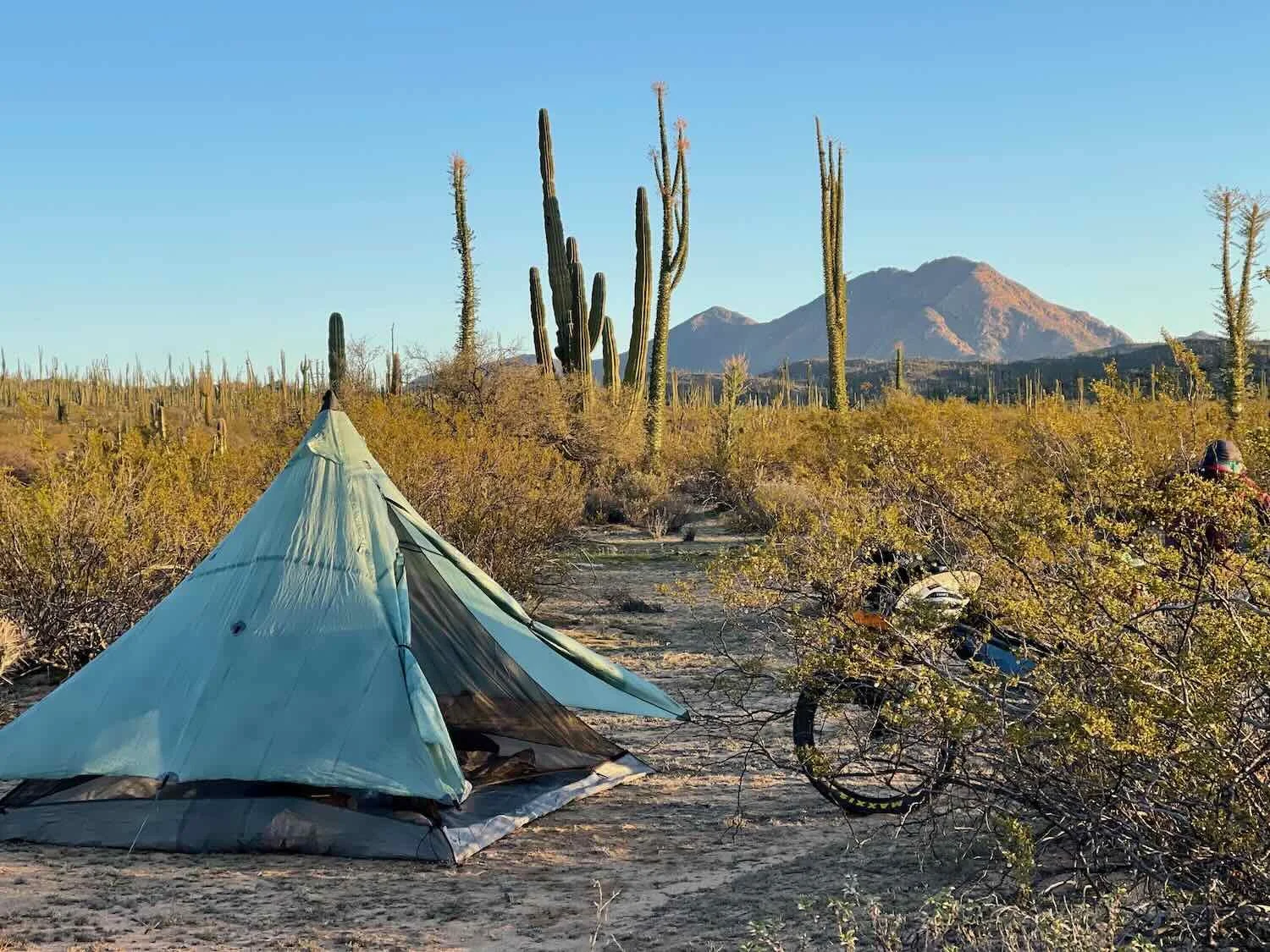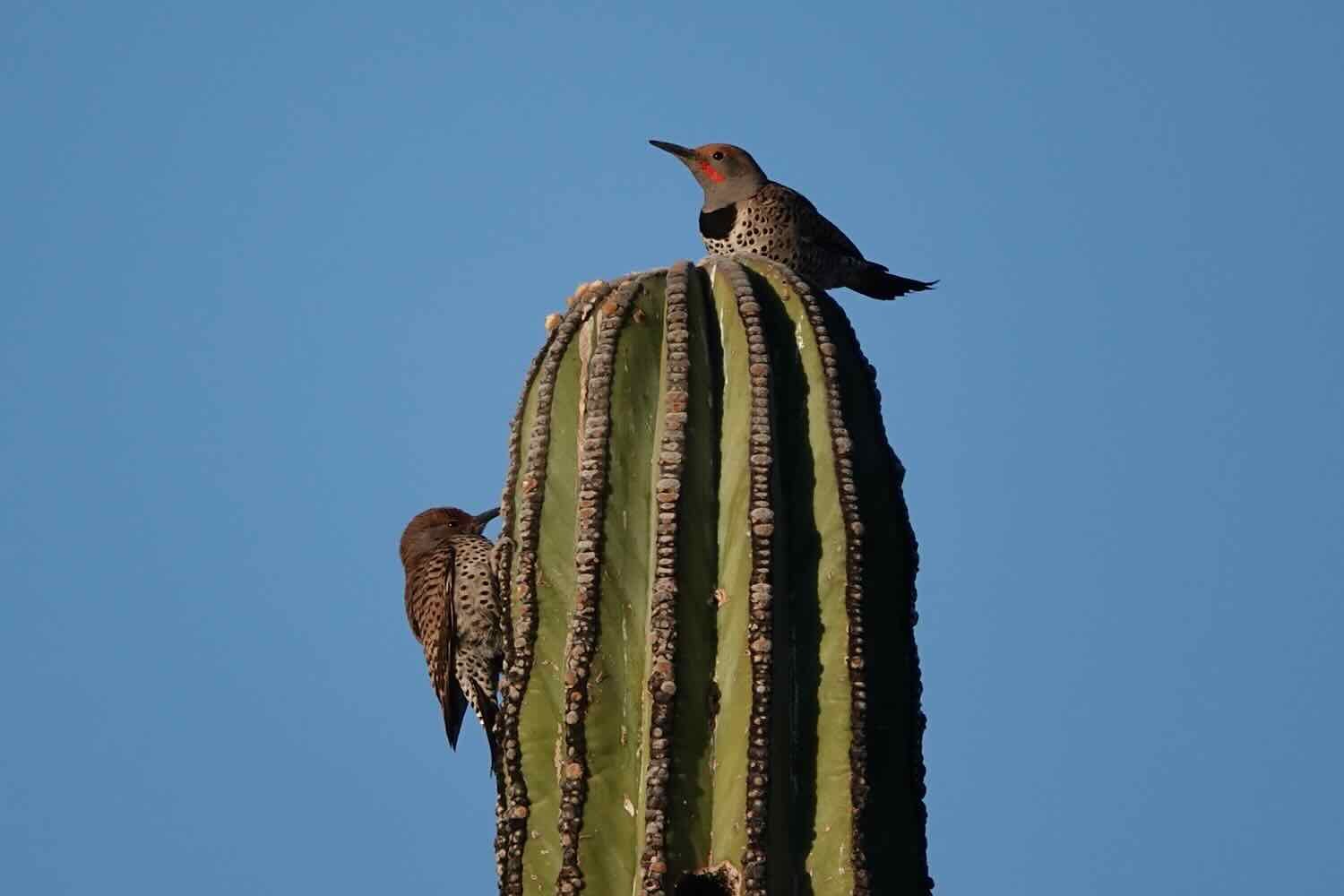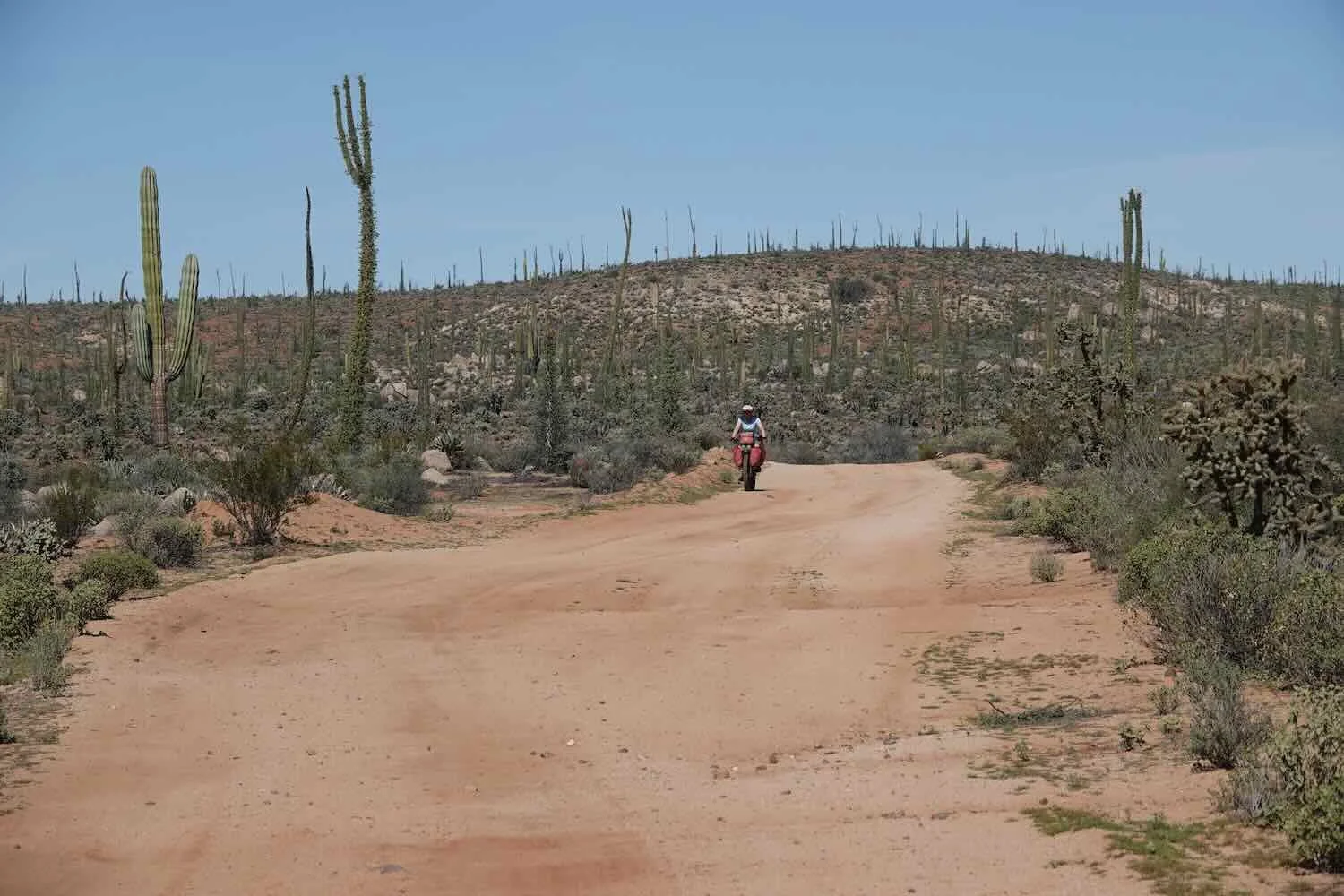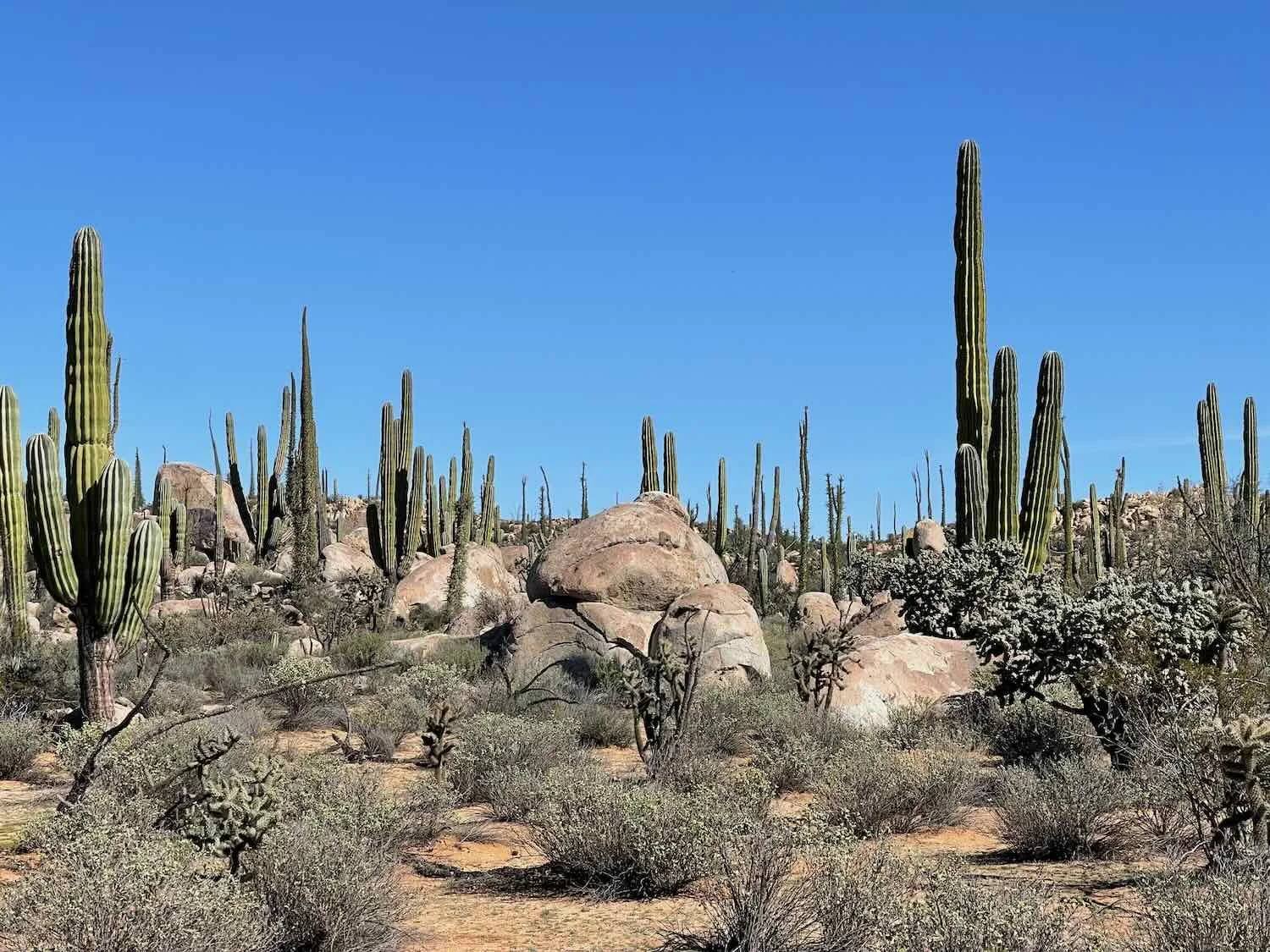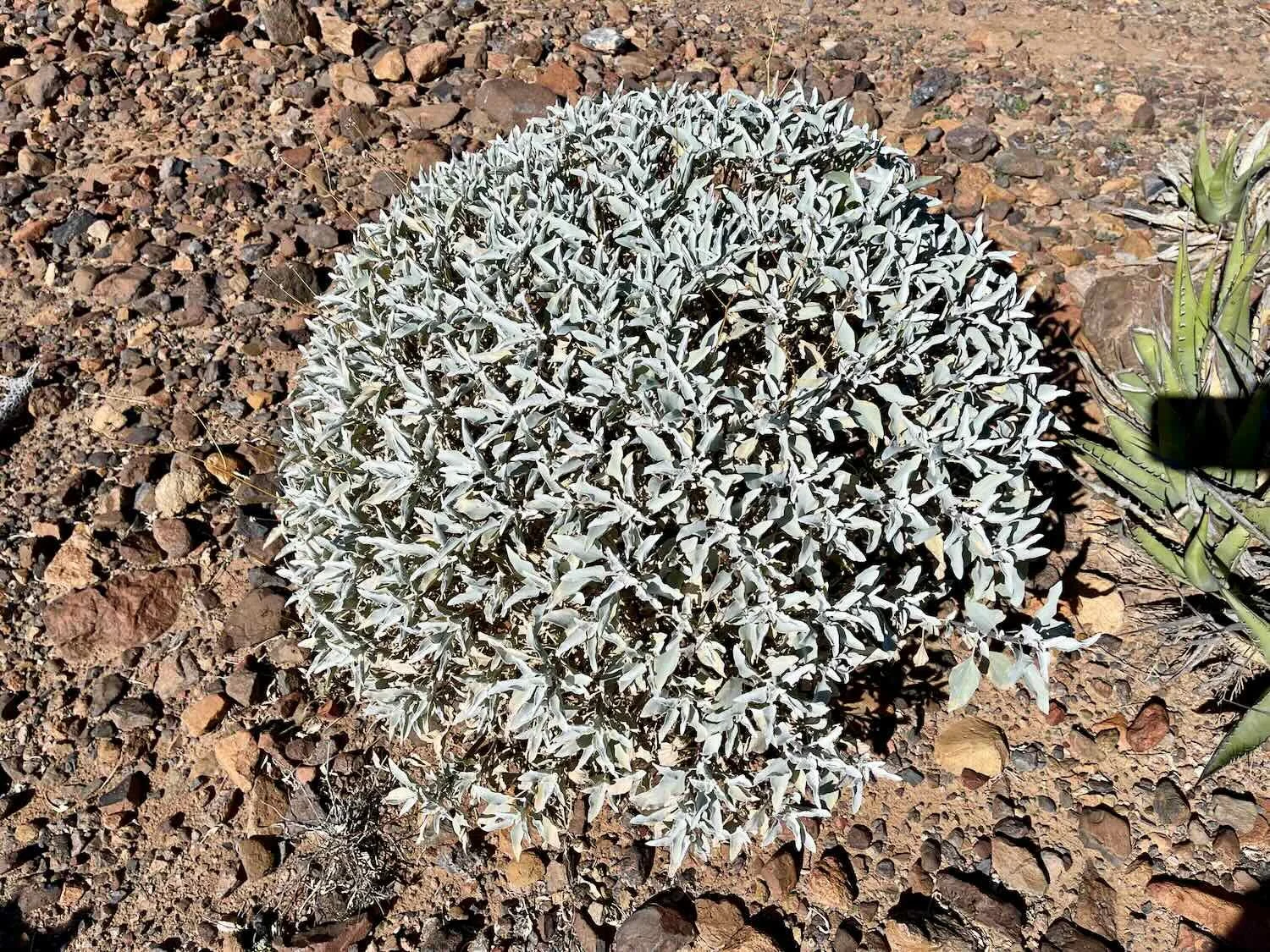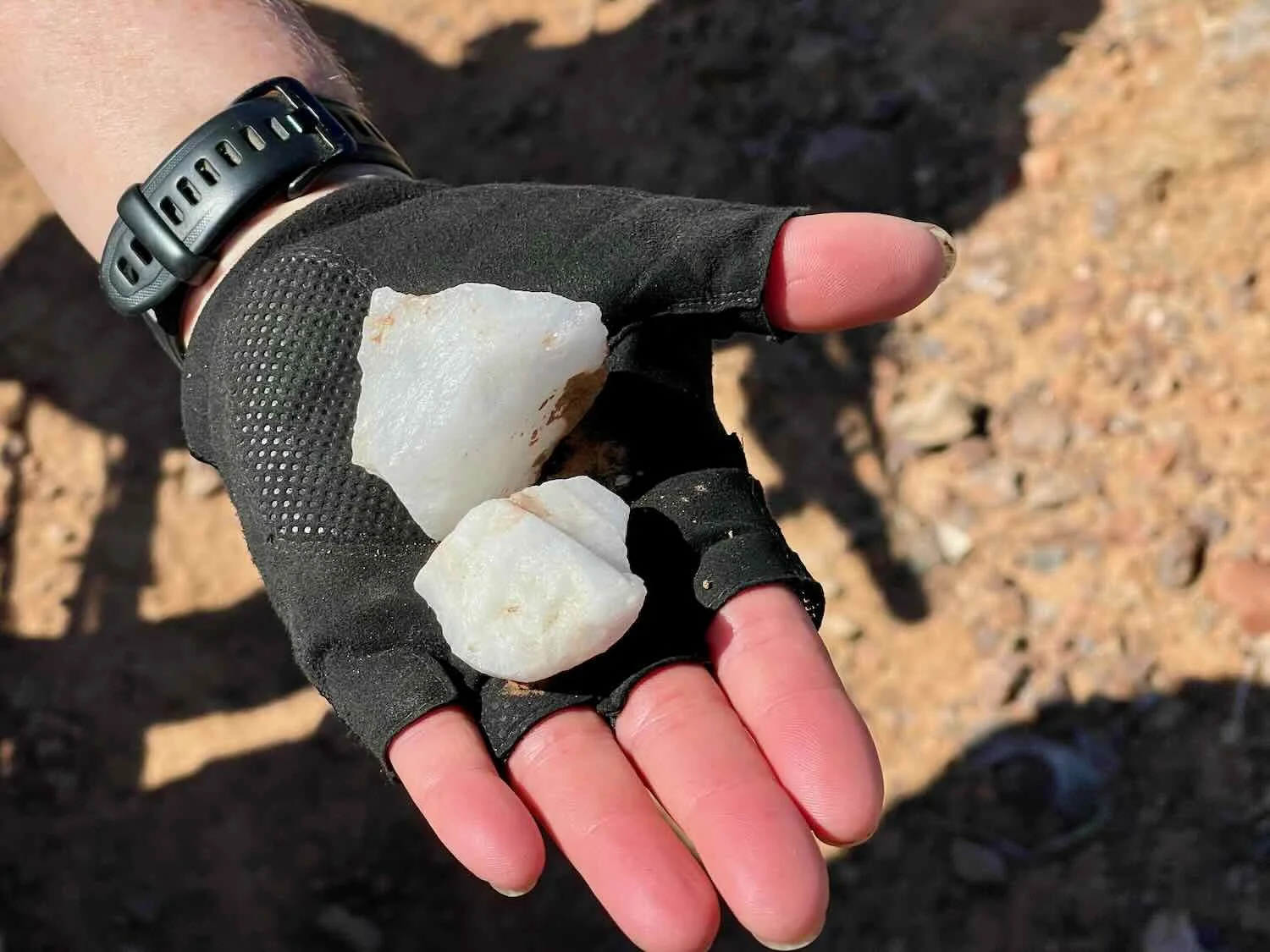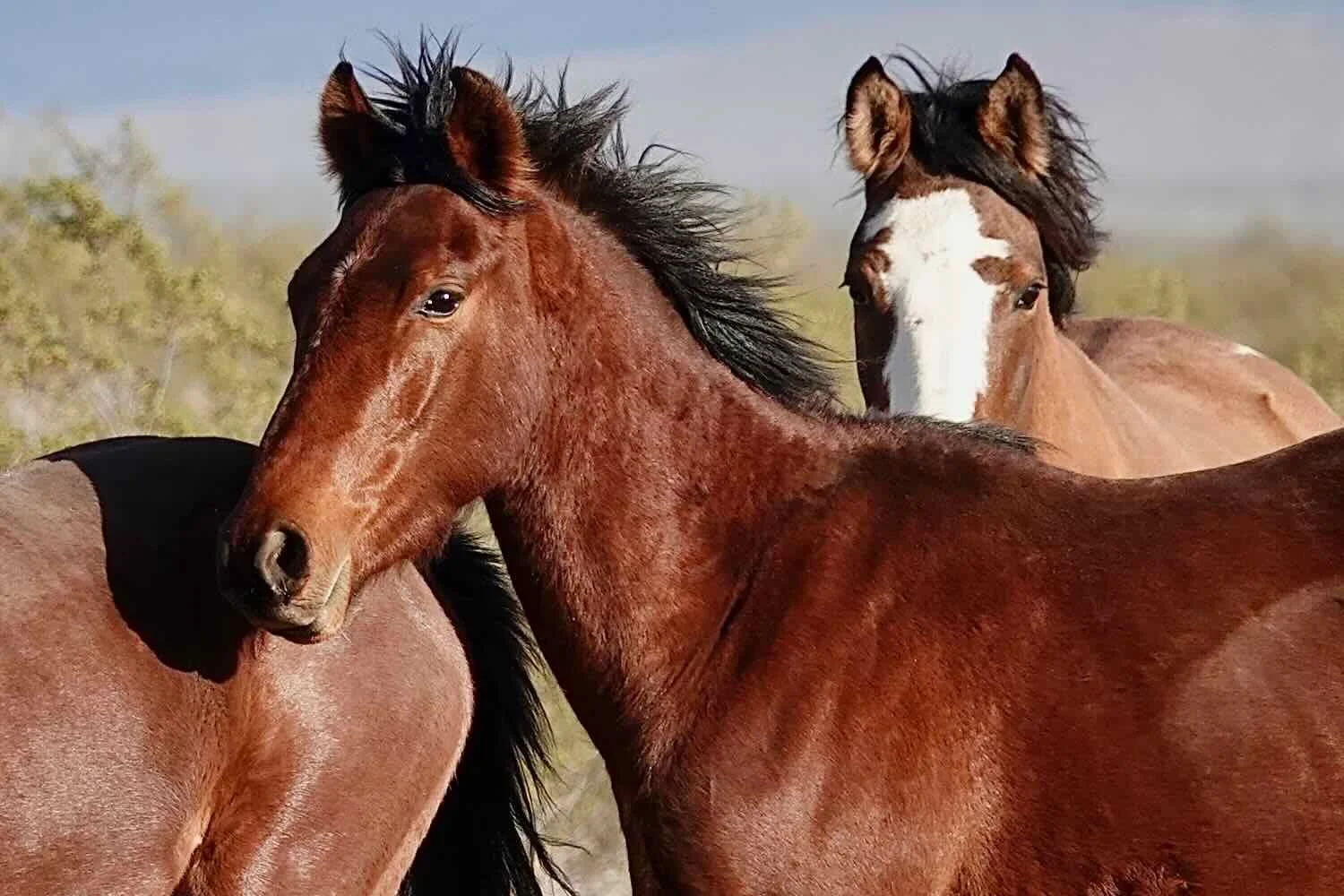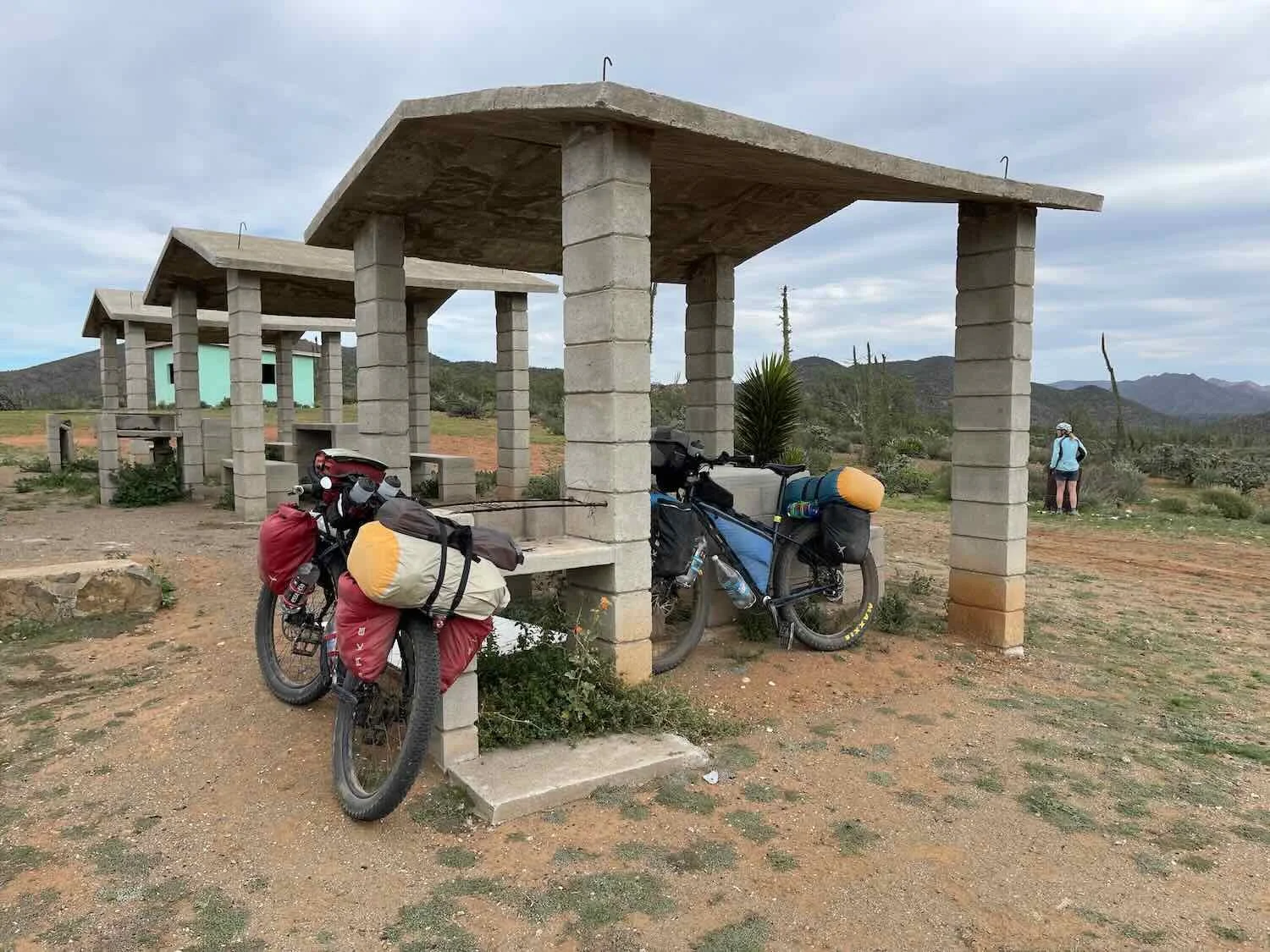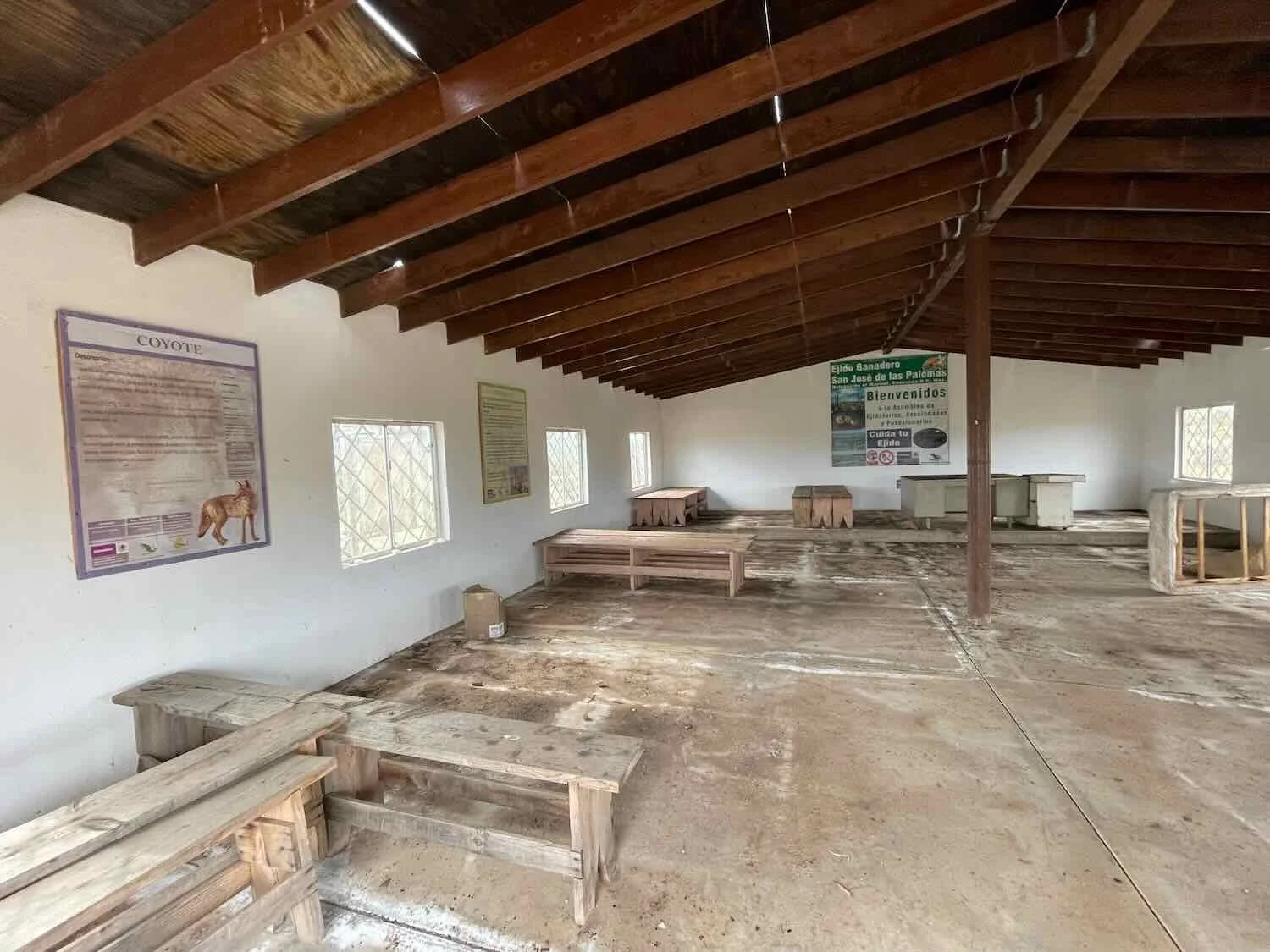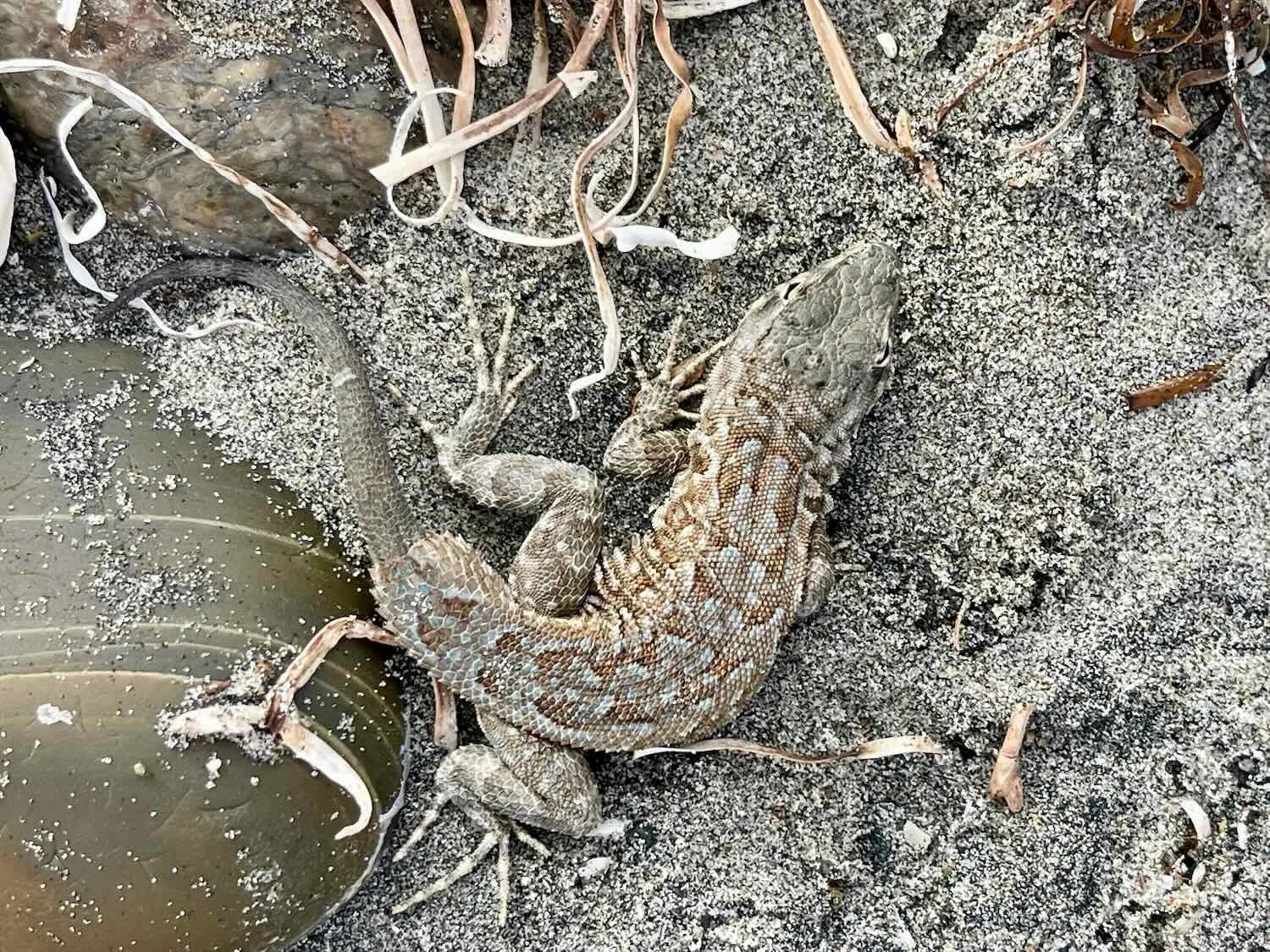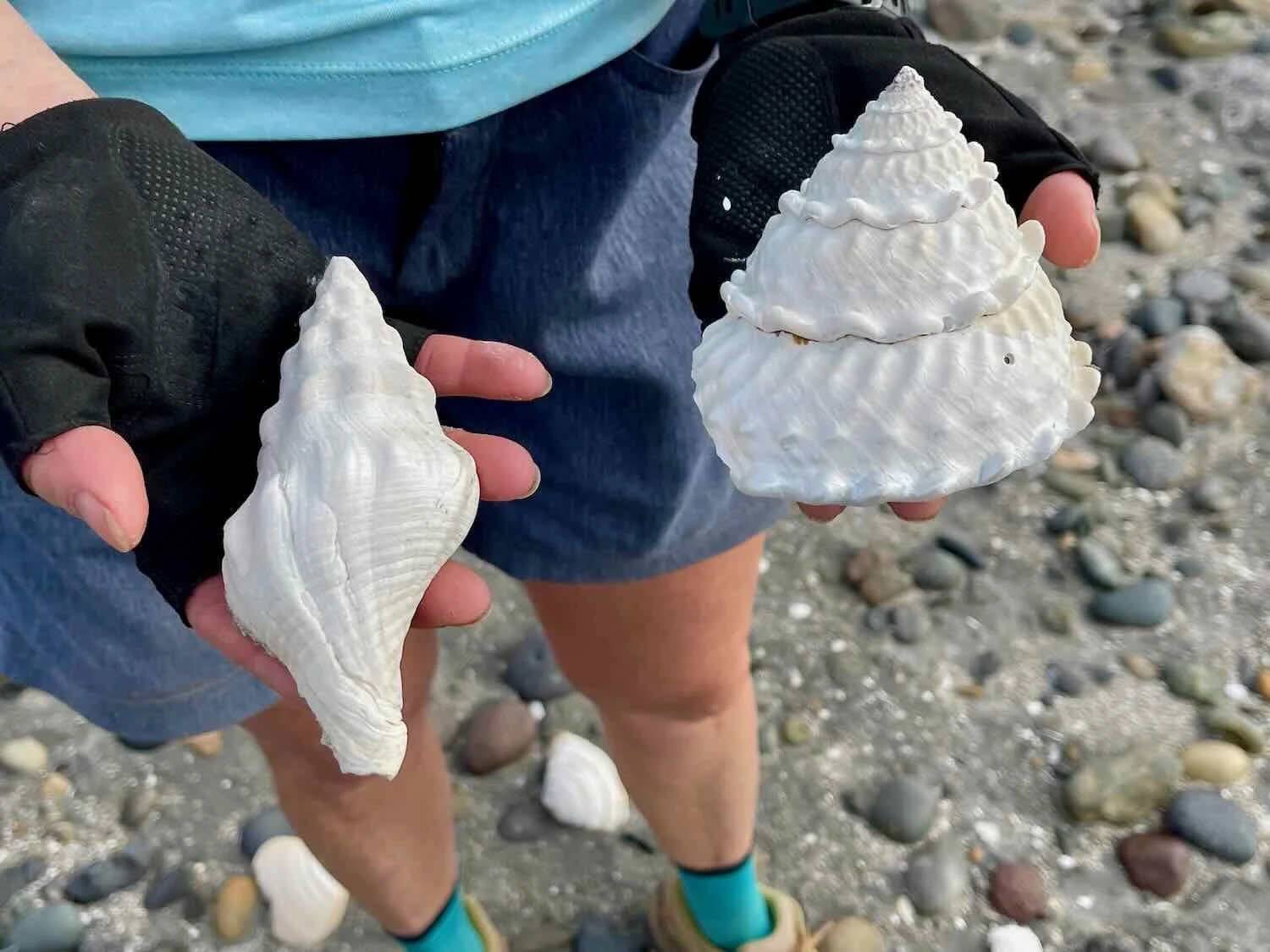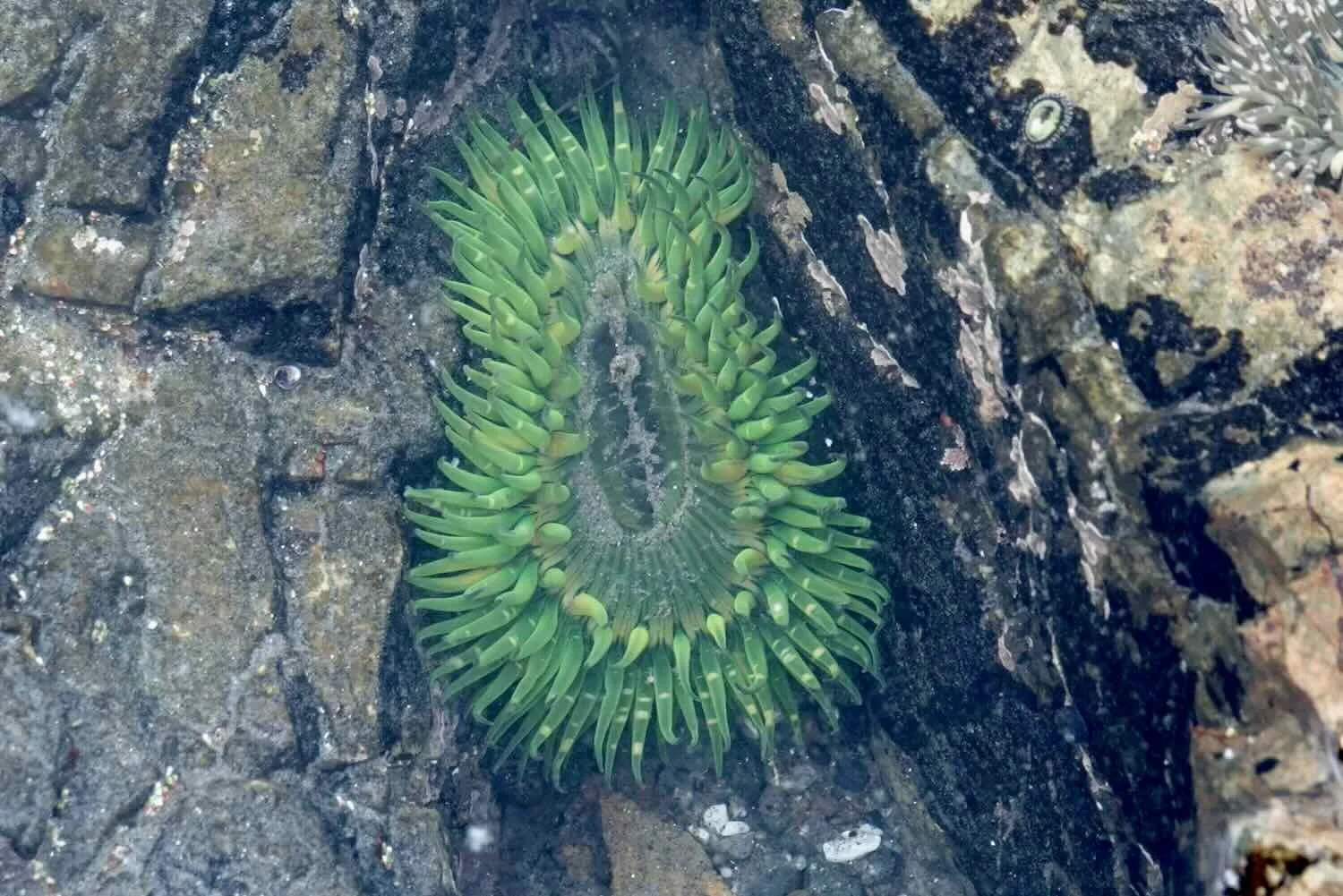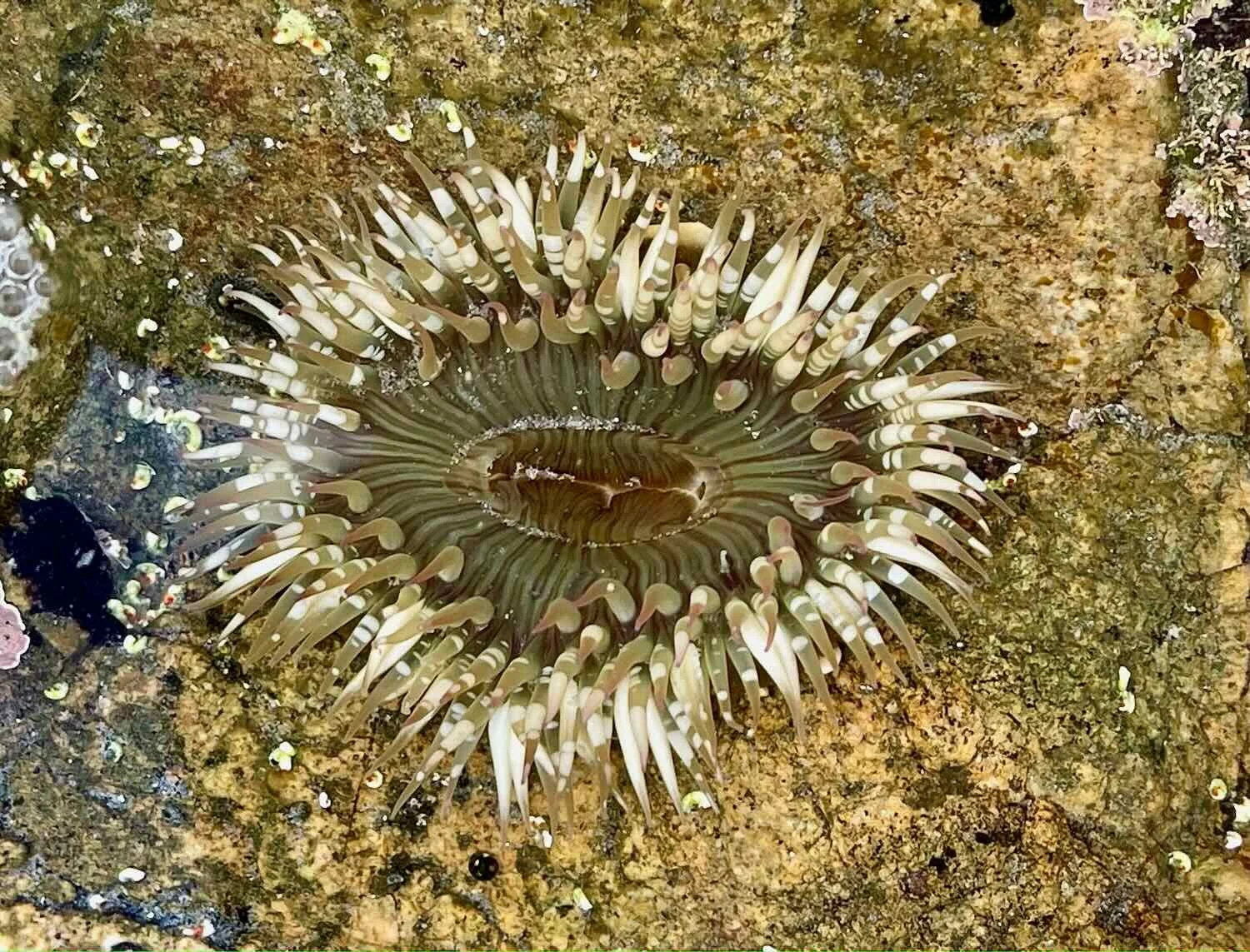Baja Divide, Part 2: Cycling from Vicente Guerrero to Nuevo Rosarito
29 January - 18 February 2023
Baja Divide Section #6
29 January - Vicente Guerrero to San Quintín (14.1 mi, 22.7 km)
30-31 January - Rain Days in San Quintín
1 February - San Quintín to Misión Santa María (19.5 mi, 31.4 km)
Baja Divide Section #7
2 February - Misión Santa María to Cerro de San Miguel Wild Camp #1 (19.8 mi, 31.9 km)
3 February - Cerro de San Miguel Wild Camp #1 to Wild Camp #2 (23.1 mi, 37.2 km)
4 February - Cerro de San Miguel Wild Camp #2 to Valle de los Cirios Wild Camp #1 (30.0 mi, 48.3 km)
5 February - Valle de los Cirios Wild Camp #1 to Wild Camp #2 (26.5 mi, 42.7 km)
6 February - Valle de los Cirios Wild Camp #2 to Cataviña (26.1 mi, 42.0 km)
7-9 February - Rest days in Cataviña
Baja Divide Section #8
10 February - Cataviña to Wild Camp near San José del Faro (44.6 mi, 71.8 km)
11 February - Wild Camp near San José del Faro to Wild Camp Punta Blanca (26.0 mi, 41.8 km)
12 February - Wild Camp Punta Blanca to Wild Camp Punta Lobos (34.2 mi, 55.0 km)
13 February - Rest Day at Punta Lobos Wild Camp
14 February - Wild Camp Punta Lobos to Santa Rosaliíta (24.6 mi, 39.6 km)
Baja Divide Section #9
15 February - Santa Rosaliíta to Ejido Nuevo Rosarito (19.4 mi, 31.2 km)
16-18 February - Layover in Ejido Nuevo Rosarito
Cycling the Highway to San Quintín
A couple of days’ rest in the bustling highway town of Vicente Guerrero gave us the boost of energy we needed for cycling the next leg of the Baja Divide bikepacking route. We were really looking forward to the upcoming segment. The route would finally take us into the heart of Baja’s central desert, which is the landscape that most people think of when they hear the word “Baja” (well, with the possible exception of margaritas on the beach). We would finally encounter more of the peninsula’s strange and unique species. Moreover, this part of the route includes the longest section of cycling without any services - a 125 mi (200 km) stretch of desert-coastal riding without any food or water resupply, making water management a challenge. It was clear that more adventure lay ahead.
In the morning light, we rolled out of town heading southward.
On the south edge of town, we passed the Hotel California. It’s probably just as well we didn’t try to stay there (based on the lyrics of that famous song by The Eagles.) Vicente Guerrero, Baja California, Mexico. Copyright © 2019-2023 Pedals and Puffins.
We spent the rest of the day cycling on the main, paved highway through the intensely farmed lowlands of the San Quintín Valley. Although it’s not as beautiful and wild as the backcountry, we still found cycling along the highway engaging. We were intrigued by the mix of small businesses and major agricultural operations we saw along the way. The big crop this time of year appeared to be strawberries.
We passed endless rows of ripening strawberries south of Vicente Guerrero. Baja California, Mexico. Copyright © 2019-2023 Pedals and Puffins.
Billboards along Highway 1 promote local businesses with bright colors and lively images evoking the products and services for sale. Santa Fe, Baja California, Mexico. Copyright © 2019-2023 Pedals and Puffins.
About 45 minutes into the ride, we reached a point where the Baja Divide route turns off of the highway and onto dirt farm roads - returning to the highway after a 16 mile detour. But the sky was overcast, threatening rain showers that would turn the farm roads into slippery mud pits. We didn’t relish the possibility of getting bogged down in the muck. So after a brief consideration of our options, we elected to continue to San Quintín along the highway.
An American kestrel surveys the agricultural fields from his perch atop a telephone pole. North of San Quintín, Baja California, Mexico. Copyright © 2019-2023 Pedals and Puffins.
Cycling on the dirt roads and paths that parallel the highway kept us safely out of the traffic lanes. With the relatively flat terrain, we made fantastic time and arrived in San Quintín before noon. We headed across town to a hotel that was within walking distance of the big Calimax supermarket, where we could buy provisions for the next backcountry leg of the journey. For the next six days of cycling, we would only pass small convenience stores. So this was our last chance to stock up on a wider variety of food.
It turned out to be a good decision. The hotel had no problem checking us in well before noon. Even better, our room had impressively strong and fast wifi, a very effective room heater, and consistent hot water in the shower (a very rare thing, even in fancier hotels). Of course, it had its quirks. For example, the only electrical outlet in the room was installed in the wall above the bed, at a disconcertingly strange angle.
The off-kilter electrical outlet in our hotel room was interesting. San Quintín, Baja California, Mexico. Copyright © 2019-2023 Pedals and Puffins.
In the afternoon we headed over to the supermarket, where we were surprised to see a Tumbleweed bicycle, the brand we ride, parked inside. We have only ever seen one other Tumbleweed bicycle in the wild, so we suspected this was George, the German cyclist we had met days earlier on the road into Ojos Negros.
Moments later, George appeared. He told us that Alejandro (from Canada) was now several days ahead of us, and George was cycling on his own. We chatted for quite a while, hearing about his plans as well as his challenges in attempting to secure more cash from a local ATM (there would be no more ATMs or chances to get cash for several weeks). Unfortunately, he was staying at a different hotel than we were. It was in another part of town, several miles away. So although we all ended up sitting out a rain day in San Quintín, we did not see George again.
After saying goodbye, we spent the next hour sorting out our food strategy for the ride from San Quintín to Cataviña. Although we planned to eat at roadside restaurants as much as possible, we still needed to carry four days worth of food. That adds a lot of weight, especially when combined with the extra water that’s also required. We tried to be careful about how much we bought, but ended up with a bit too much food anyway. At least we wouldn’t go hungry.
Rain Days in San Quintín
We spent the next day hunkered down in our room as a heavy rain fell outside. It had rained steadily overnight, turning the dusty corridors that line the highway into sticky mud pits embellished with large, chocolate-brown pools of water. It is literally impossible to ride the dirt roads in the area when they are wet. The dirt turns into peanut butter mud which sticks to everything.
However, we did have to go outside for dinner. The little taquería across the street had some local, patrons which is always a good sign. We decided to give it a try. It was a simple building with dirt floors, plastic tables, and walls on only two sides. But the tacos were delicious, and we ended up back there a couple of times.
Taquería Matias serves up fresh and tasty tacos along the highway. San Quintín, Baja California, Mexico. Copyright © 2019-2023 Pedals and Puffins.
It rained all night during the second night of our stay as well. The next morning we had planned to hit the road, and we actually packed up all of our stuff preparing to depart. But when we looked outside, it was clear that there was still a lot of standing water and mud. A short walk to the store on the corner confirmed that there would be a lot of mud to contend with out on the trail.
We made the decision to stay in San Quintín one more day. That way, we would be able to cycle on the dirt roads of the Baja Divide route - rather than having to take the highway for another day to avoid the mud.
The Wetlands and Beaches of Bahía San Quintín
Our route out of town headed westward toward the northern tip of one of Baja’s most pristine coastal bays - the Bahía San Quintín. From there, we headed southward across the flooded wetlands and fertile grasslands of the San Quintín Nature Reserve, which protects the lands surrounding the bay. Immediately, we were struck by the abundance of bird life - which was much more varied and easy to see than when we had cycled through the Sierra Juarez mountains. Flocks of herons, egrets, shorebirds, and meadowlarks hunted for insects in the marshes and fields, while raptors soared overhead.
A flock of long-billed curlews, flying over an open field. Bahía San Quintín, Baja California, Mexico. Copyright © 2019-2023 Pedals and Puffins.
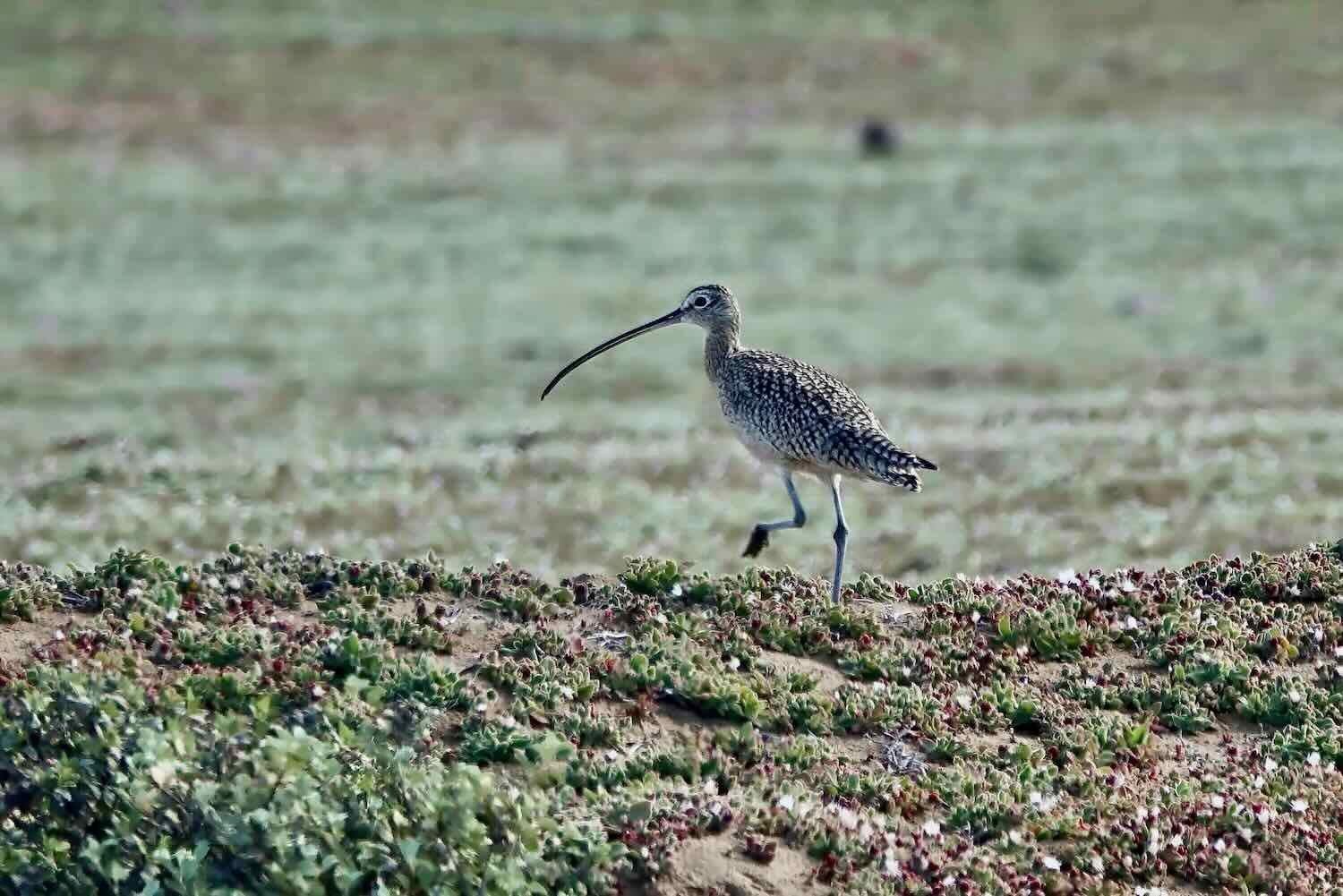
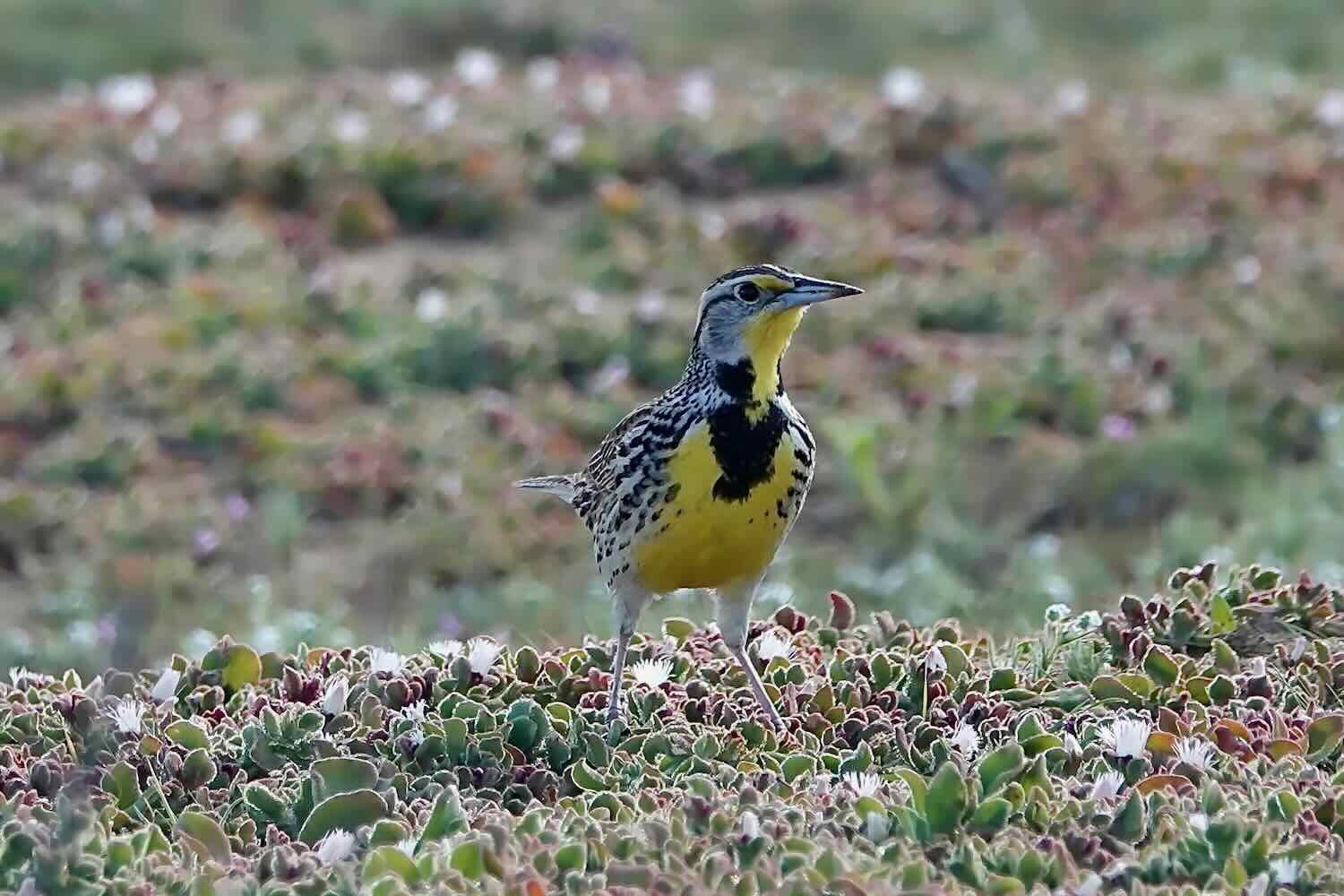
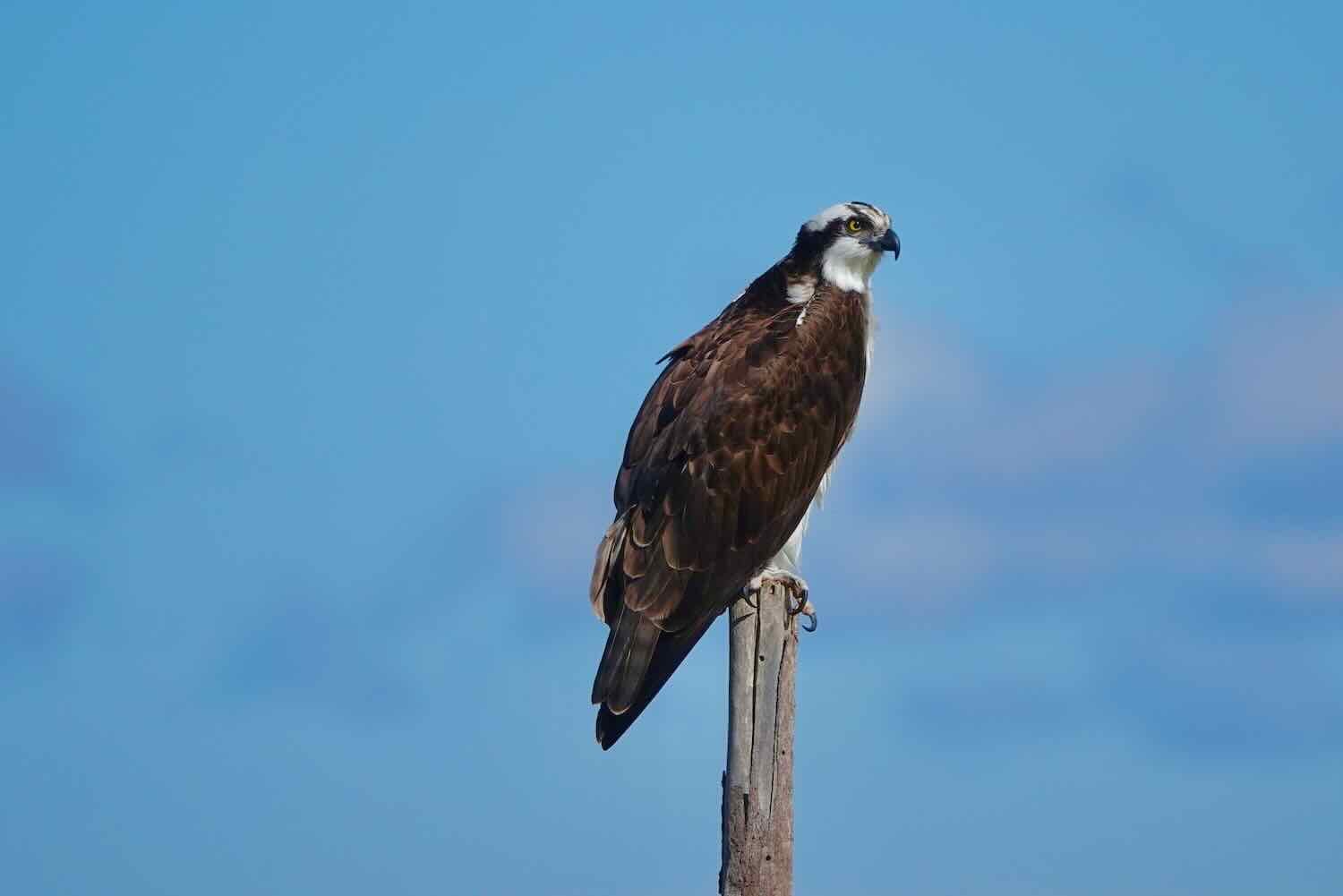
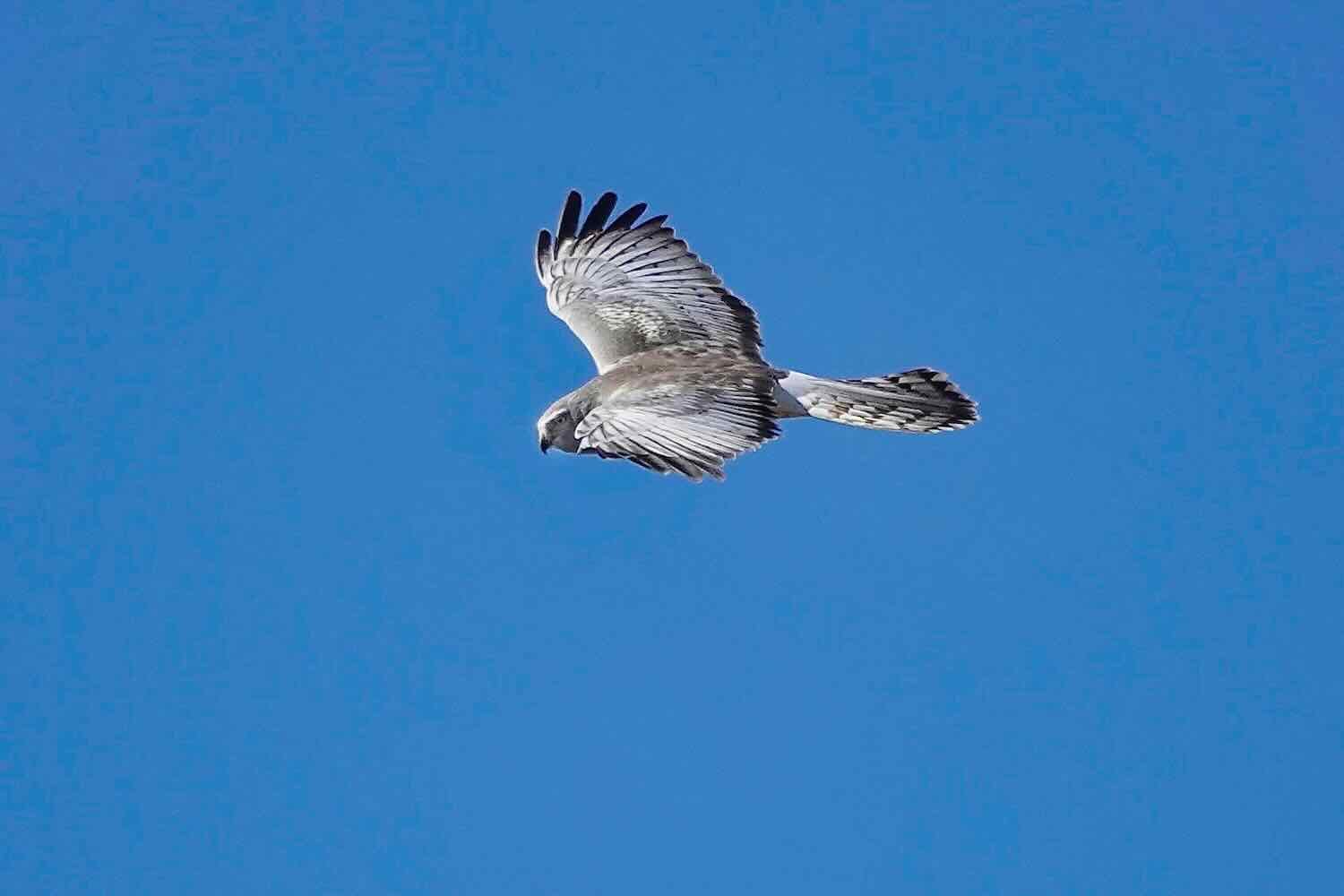
A couple of hours into the ride, we came to an abandoned hotel on a high point overlooking the bay. Walking to the edge of the hill, we were impressed to see several very large flocks of geese resting on the sandy shoreline. They turned out to be black brant geese, and there were hundreds of them. We later learned that this bay is one of the most important overwintering sites for this subspecies of brants, with 30%+ of the global population spending the winter here. That would be about 40,000 birds. We definitely didn’t see that many, but it’s a very big bay and there certainly could have been more large flocks out there.
A couple of large flocks of black brant geese were hanging out along the shores of Bahía San Quintín. Baja California, Mexico. Copyright © 2019-2023 Pedals and Puffins.
As we were getting ready to leave the abandoned hotel site, an older, local gentleman walked up to greet us. He was eager to talk, and to make us feel welcome. Even with our still-limited Spanish vocabulary, we were able to enjoy connecting with him. He expressed amazement that we were riding our bikes as far as La Paz (at the southern tip of Baja). He told us that he had ridden on some of the area’s dirt roads via motorbike, and he thought that was hard enough. But we all agreed cycling is healthier, and he congratulated us on our stamina. From the hilltop, he pointed out where his house was located in the nearby grasslands. He obviously loved the beauty of the bay, and sharing the site with us. But eventually we felt the need to get rolling, and said good-bye.
The next part of the ride took us along tracks that were covered with deep sand. Most of it was rideable, but there were definitely a few sections where it was easier just to push our bikes through.
Cycling through the sand. Bahía San Quintín, Baja California, Mexico. Copyright © 2019-2023 Pedals and Puffins.
We stopped to check out this abandoned ranch building along the route. It looked as if it had been a pretty fancy home at one time. But it had long since lost its roof, and the exterior facade was crumbling away. Bahía San Quintín, Baja California, Mexico. Copyright © 2019-2023 Pedals and Puffins.
Rough-hewn, barbed wire fences often lined the edge of the road. Bahía San Quintín, Baja California, Mexico. Copyright © 2019-2023 Pedals and Puffins.
After about 4.5 hrs, we reached the end of the bay, and our route took us out onto the beach. The sand was packed hard, so we could ride on the beach easily enough, if not particularly fast.
Cycling on the sand at Playa Santa María. Baja California, Mexico. Copyright © 2019-2023 Pedals and Puffins.
As one of our weight saving measures (i.e., to carry less food), we had planned to stop for a late lunch at the upscale Hotel Misión Santa María, that sits on a sand dune close to the beach. The staff at the hotel were wonderfully helpful, and let us store our bicycles in a luggage room while we ate. The restaurant was an oasis of tranquility, and the food was delicious. Before long, the idea of camping on the beach for the night faded away - we decided to cut our ride short and spend the night at the hotel.
Our stay at the Hotel Misión Santa María was a real treat. It was a fairly large hotel, but we were almost the only ones there (other than 2-4 other people we saw only briefly). We had a large room with a balcony that had a nice view of the ocean.
After settling in, we took a long walk on the seashore. The most striking aspect of the beach was that it was covered with thousands of lovely, whole, sand dollars. The sand dollars seemed to outnumber almost all of the other types of seashells (except the clams). We also were delighted to spot a snowy plover a fairly rare species which is declining because of its proclivity to nest on beaches also favored by people. Beach goers will sometimes unknowingly crush the camouflaged eggs while walking around. Much like the black brant geese we saw earlier, San Quintín is an incredibly important area for snowy plovers. Nearly 50% of Baja’s snowy plovers breed in the San Quintín region, and the population grows even bigger in the winter, with additional birds arriving from the north.
Three of the many sand dollars we saw along the beach. Playa Santa María, Baja California, Mexico. Copyright © 2019-2023 Pedals and Puffins.
Snowy plover. Playa Santa María, Baja California, Mexico. Copyright © 2019-2023 Pedals and Puffins.
We weren’t the only folks out on the beach. There were hardly any other tourists. But out in the surf, locals were busy fishing and clamming.
This pair seemed to be related to each other. The man was casting a hand-held fishing line, while the boy dug for clams in the surf. Playa Santa María, Baja California, Mexico. Copyright © 2019-2023 Pedals and Puffins.
Finished clamming for the day, this guy headed back to the nearby town. Playa Santa María, Baja California, Mexico. Copyright © 2019-2023 Pedals and Puffins.
The hotel by the beach was located a little over a mile from the nearest town. But since we had plenty of time, we walked across the dunes to buy a few drinks and snacks from the local abarrotes store. Along the way we passed a mural painted with a fanciful scene. It depicted cartoon-like children playing among more lifelike wild creatures. Some of the animals were local, like pronghorn antelope, an eagle, and a wolf. But others were more outlandish, like a fat, prehistoric-looking lizard, a giraffe, and elephants. It was a fascinating piece of art.
Wall mural with an eclectic selection of wildlife, and cartoon-like children at play. Santa María, Baja California, Mexico. Copyright © 2019-2023 Pedals and Puffins.
We ended the evening with another meal in the lovely restaurant. A couple of margaritas rounded out the menu. Playa de San Quintín, Baja California, Mexico. Copyright © 2019-2023 Pedals and Puffins.
Up and Into the Desert Mountains
We had a big day planned, so we shoved off early the next morning. After a quick breakfast of muffins and cookies at a highway convenience store, we turned back onto the dirt and headed into the Cerro de San Miguel mountains. Right at the edge of town, we were treated to the sight of one of the most brilliantly-colored birds in the Americas. A diminutive vermillion flycatcher was chasing insects from his perch on a low bush.
Vermillion Flycatcher. Nuevo Odisea, Baja California, Mexico. Copyright © 2019-2023 Pedals and Puffins.
From the small highway town of Nueva Odisea, we had more than 1,500 ft (2,415 m) of elevation gain ahead of us. Needless to say, we would be cycling uphill all day. And we were finally heading into Baja’s central desert - the most iconic landscape on the peninsula. In fact, the central desert is probably the most photographed region in Baja outside of the southern cape. This is where some of the most weird and wonderful Baja plants can be found.
As we climbed our way slowly up the hills, the diversity of cacti quickly multiplied. The first oddity was a hillside full of the long, wavy arms of something called the galloping cactus (endemic to Baja). The name certainly fits the plant. It’s jumble of long, curvy stems - each one as thick as your arm - seem to be in a hurry to spread chaotically over everything in their path. A hillside covered with galloping cactus almost seethes with a sense of movement, looking like a garden of Medusa’s hair, covered in lethal spines.
A clump of galloping cactus extends its spiked arms across the land. Cerro de San Miguel, Baja California, Mexico. Copyright © 2019-2023 Pedals and Puffins.
Perhaps the most recognizable cactus of the Baja desert is the cardón cactus (a.k.a., the elephant cactus, a Baja endemic). And we were delighted to finally encounter these massive trees. They are reminiscent of the famous saguaro cactus that grows in the American southwest, but they are much bigger in almost every way. They can grow as high as a six story building (20 ft taller than a saguaro), live 300 years (100 more than a saguaro), and weigh up to 25 tons (more than twice as much as the heaviest elephant on record). That’s really big.
This was one of the biggest cardón cactus trees (a.k.a., elephant cactus) that we saw. It must have been over 50 ft (15 m) tall. (Note the small figure of PedalingGal standing to the left of its trunk.) Valle de los Cirios, Baja California, Mexico. Copyright © 2019-2023 Pedals and Puffins.
And there were many other wonderful plants, most of which can only be found in Baja. Page through the gallery below to get a taste of what we saw.
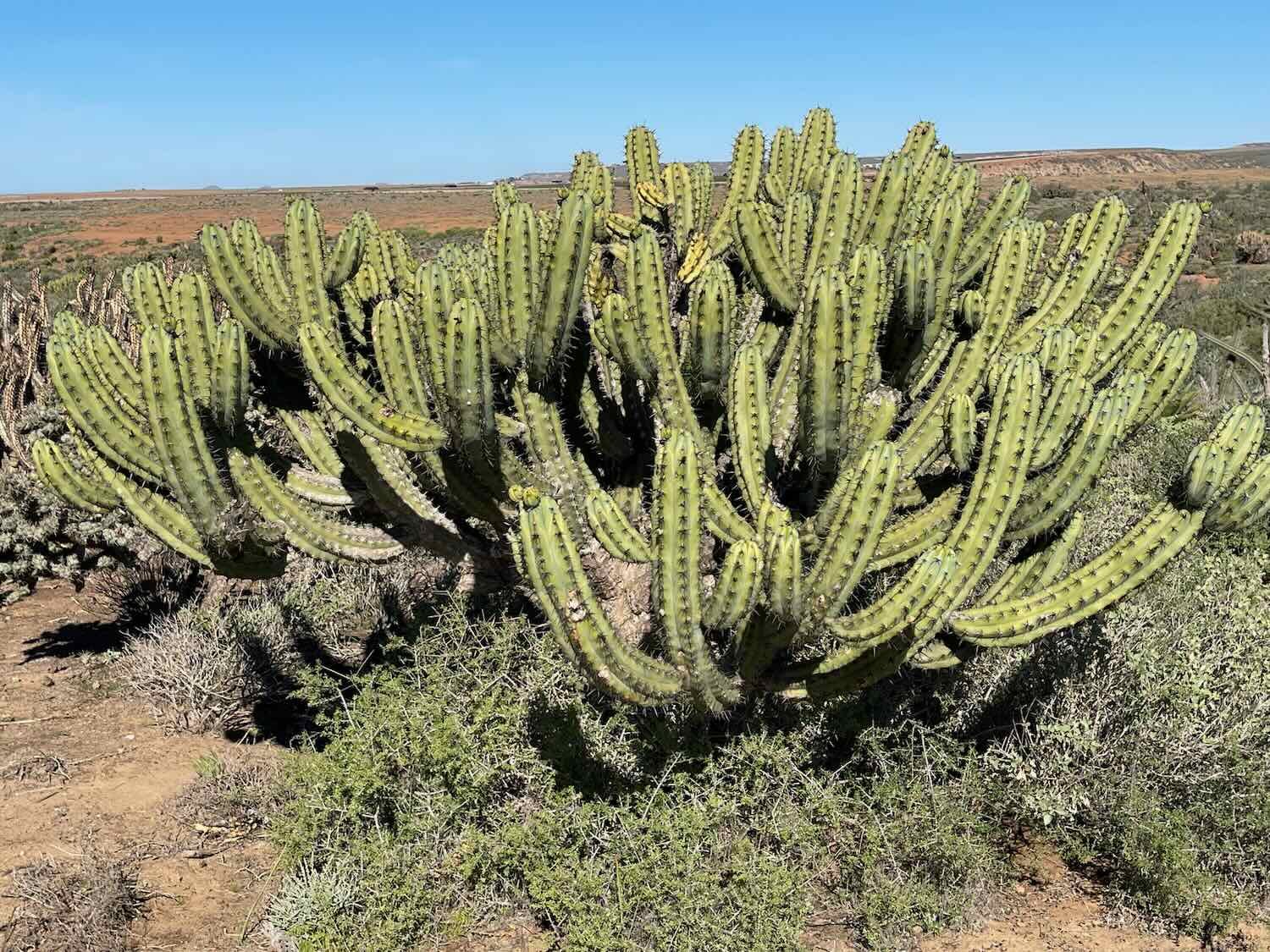
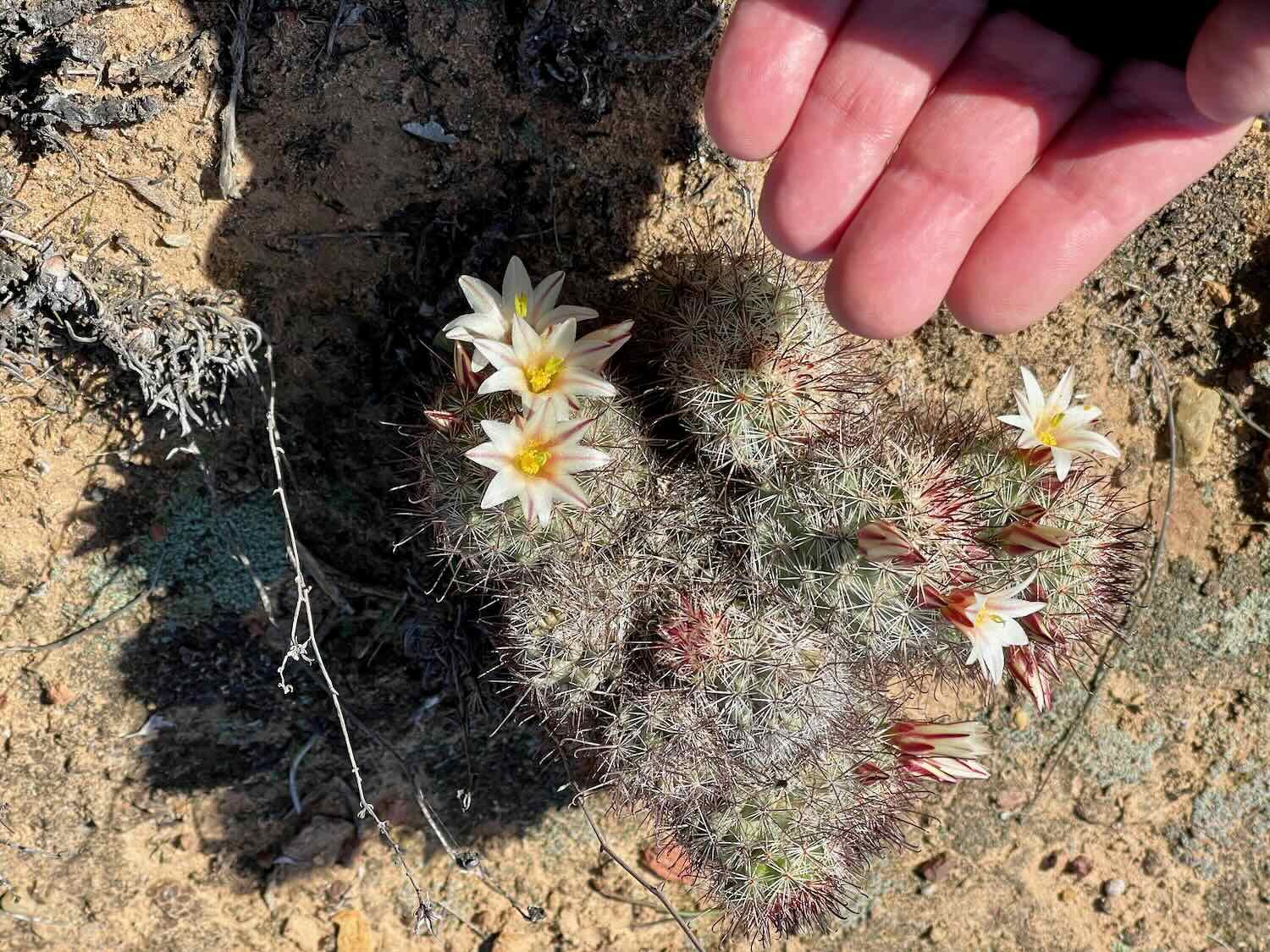
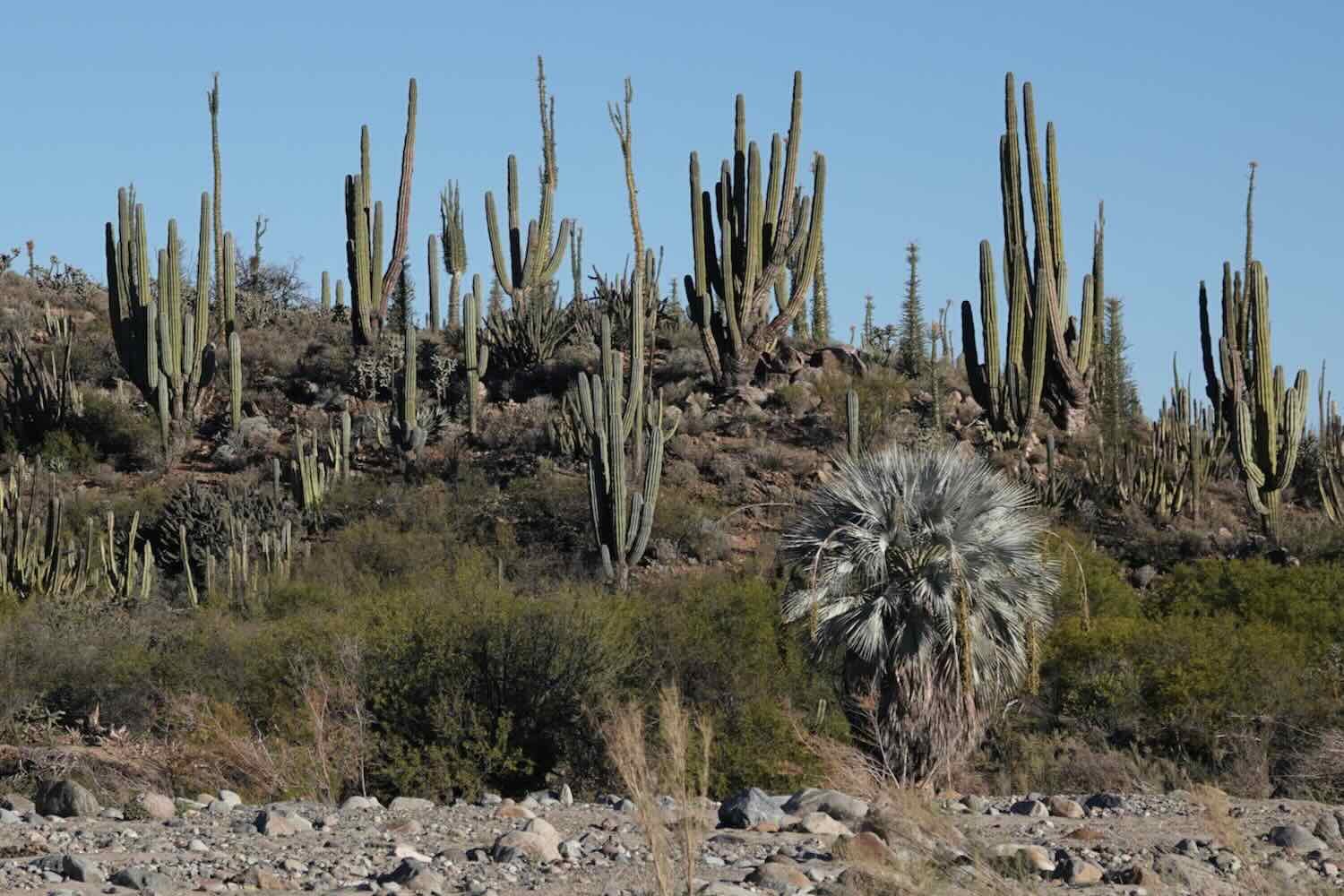
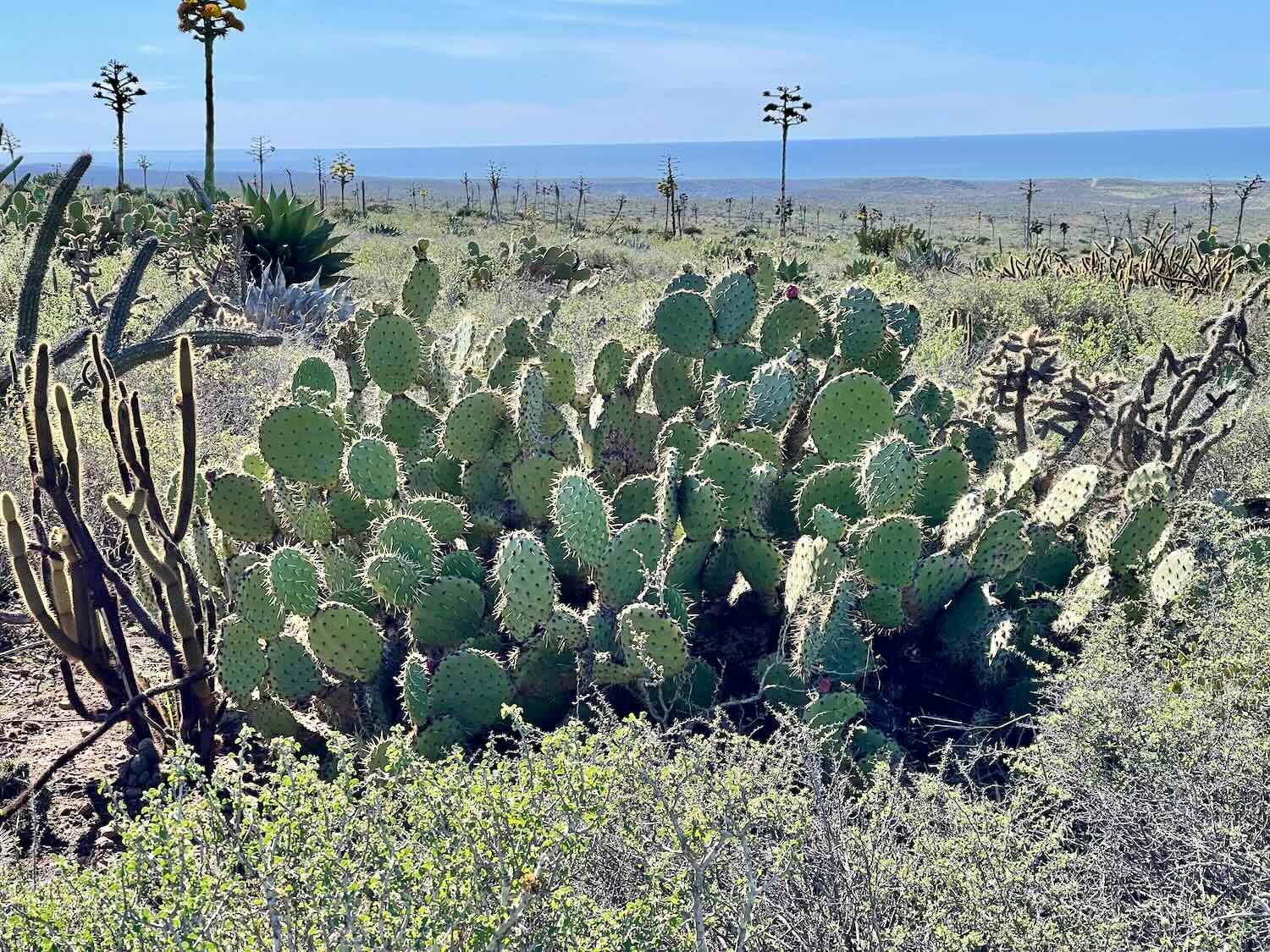
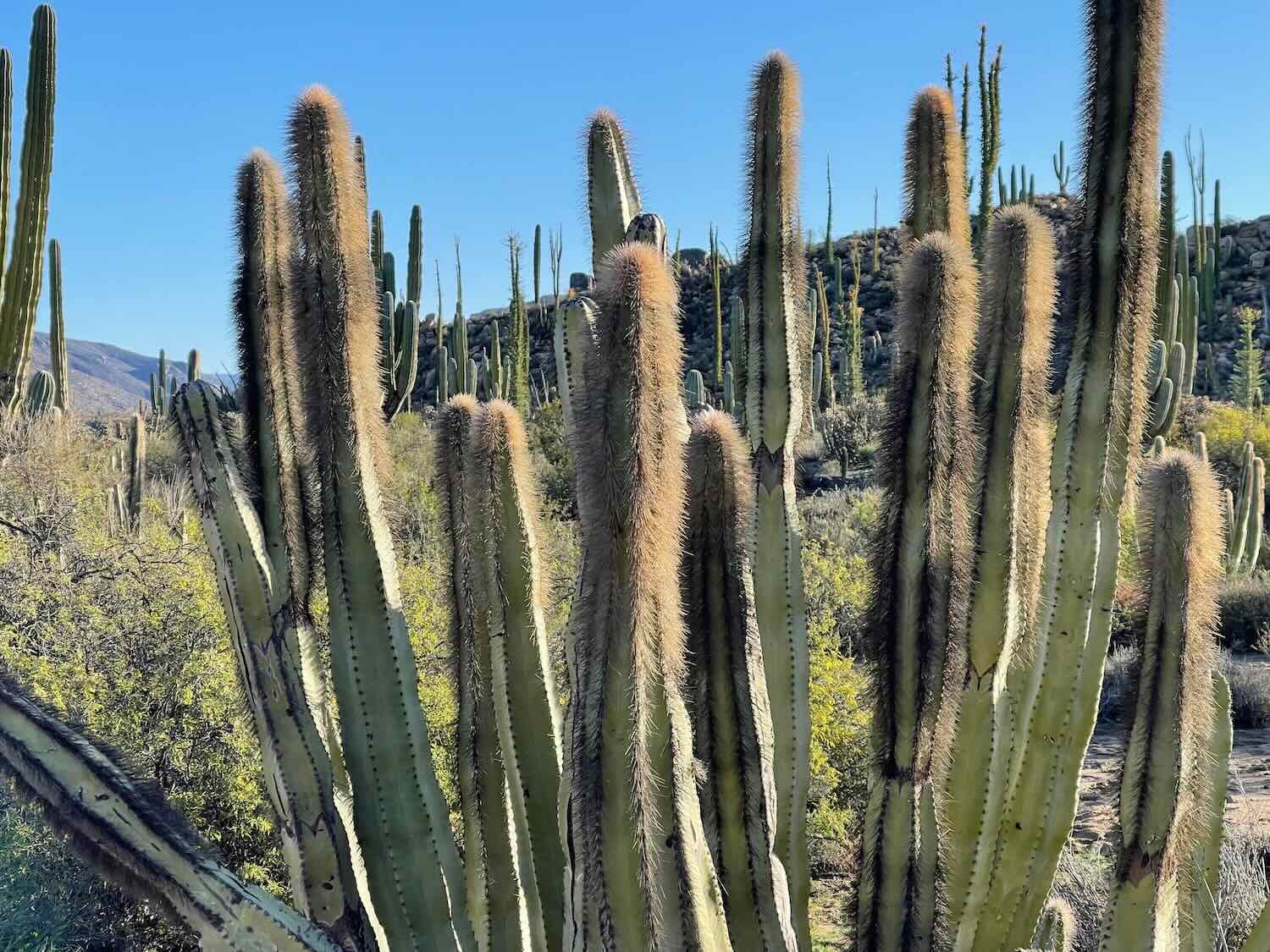

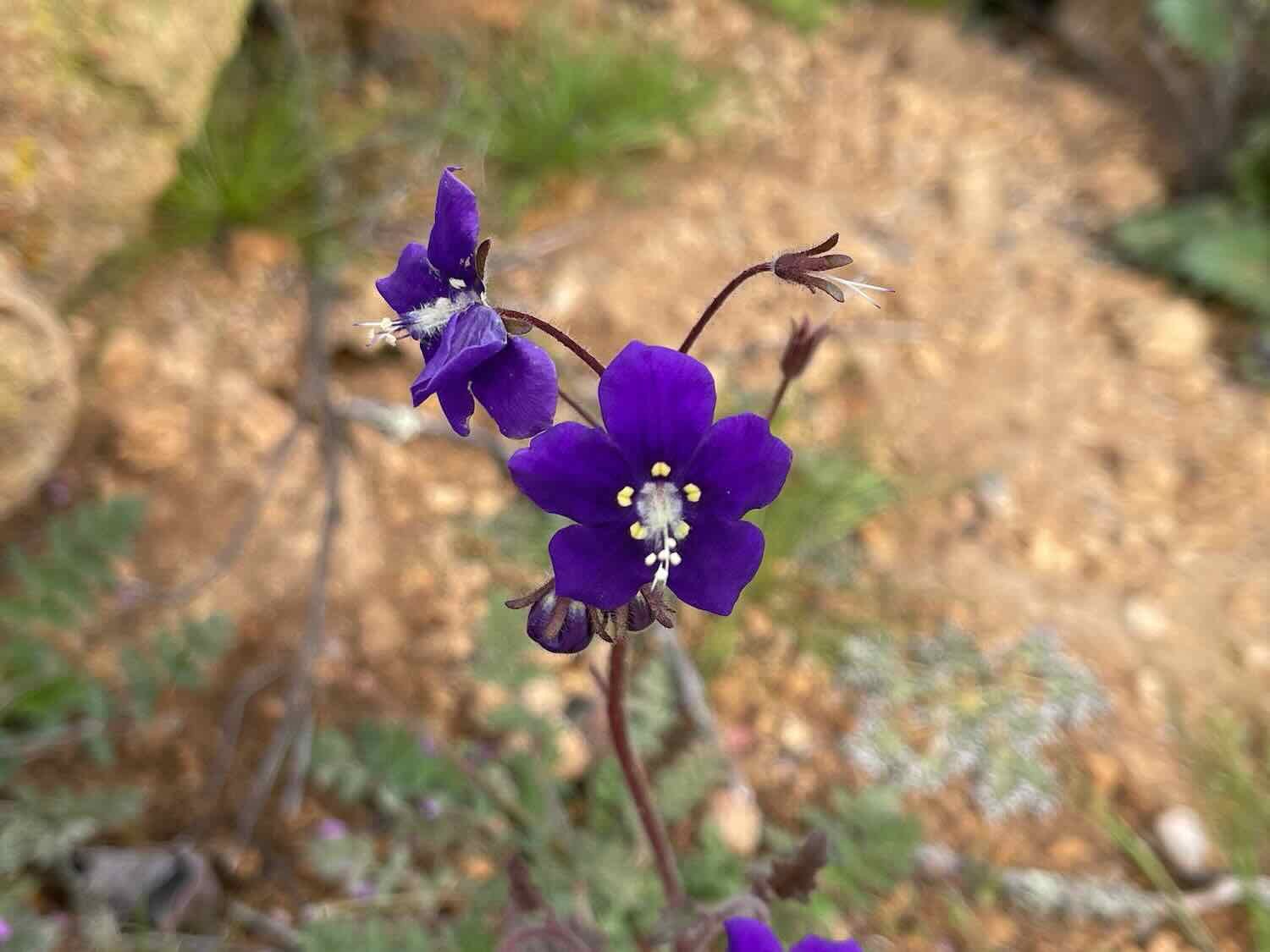
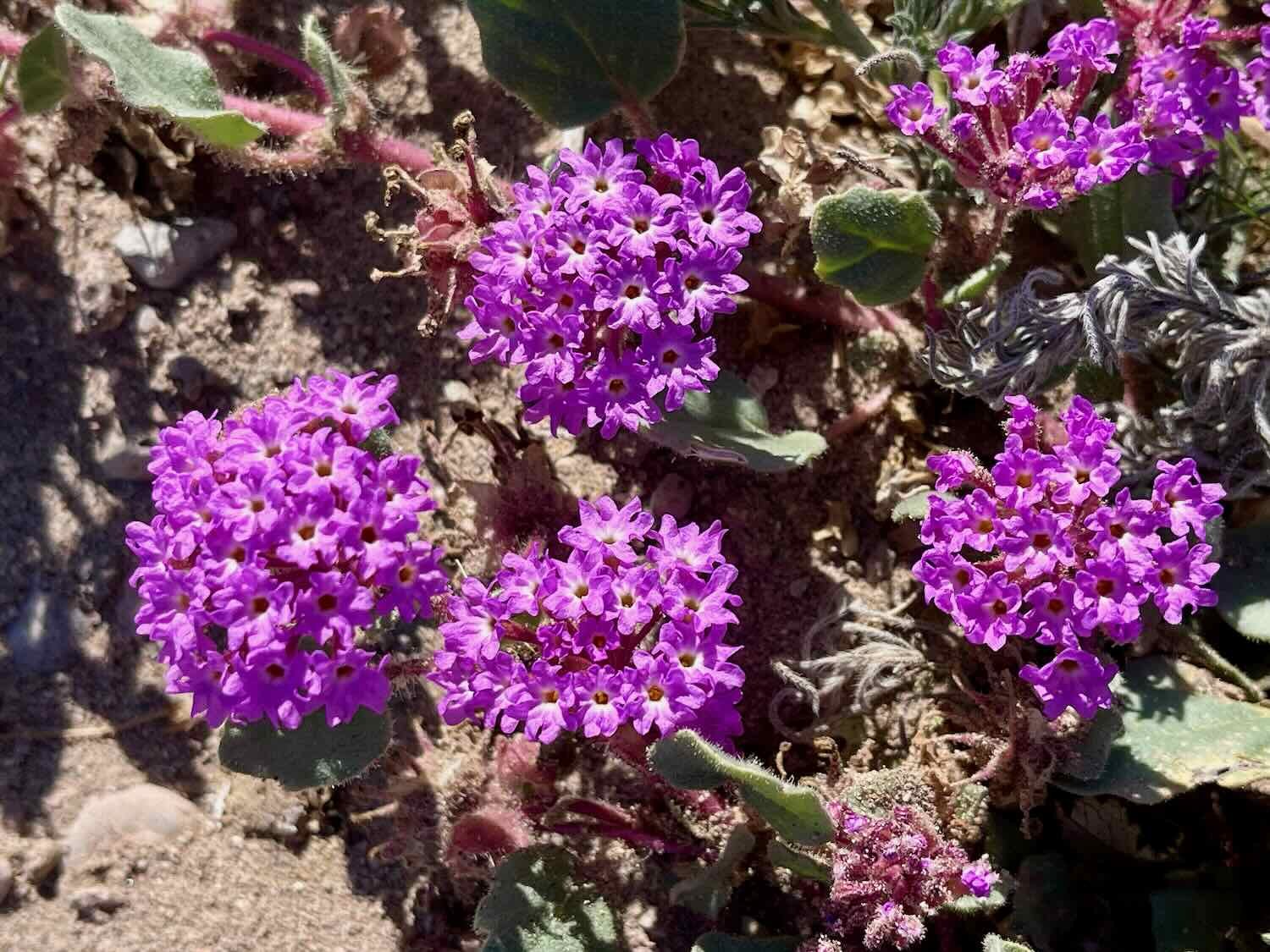
By mid morning it was quite warm. Pretty soon we were both cycling in shorts and short sleeves for the first time in a very long time. We also ended up drinking a lot of water.
And in spite of being out in the middle of nowhere, we ended up doing a lot of socializing with other cyclists on our first day in the desert. First, we were overtaken by Connor, Carson and Adam. We chatted with them for quite a while about equipment. Then suddenly, Carson noticed PedalingGal’s click-stand (used to prop up the bike while parked) and asked, “Hey, did you guys lose a click-stand?” Yes!!! PedalingGuy had accidentally left his click-stand by the side of the trail way back on our second day out of Tecate, Mexico - exactly two weeks ago.
Amazingly, Adam had stopped at the same spot, saw the click-stand on the ground, picked it up, and had been carrying it ever since in the hopes of returning it to it’s proper owner. Honestly, we did not expect to ever see that piece of equipment ever again. And losing it had been a big blow, because PedalingGuy could no longer prop up his bike when we stopped. Instead, he had to lay his bike on the ground, which was really inconvenient. Regaining the click-stand was a fabulous moment, prompting Adam to break out into an a capella rendition of the song “Reunited.”
PedalingGuy is thrilled to be reunited with his click-stand, thanks to Adam’s sharp eye (Connor and Carson in the background). Cerro de San Miguel, Baja California, Mexico. Copyright © 2019-2023 Pedals and Puffins.
Within a couple of hours after that we were passed by Fred, who had previously been cycling with Adam, Carson and Connor, but had stopped for breakfast in town before heading up the mountain. And then we were passed by two more guys from England. Each time, we stopped to introduce ourselves and get to know a little bit about them. It was quite a day, since encounters with other cyclists are usually rare. In between all the socializing, we continued our slow climb up the mountain.
Climbing up into the Baja desert mountains. The San Quintín Valley and Pacific Ocean can be seen in the distance. Cerro de San Miguel, Baja California, Mexico. Copyright © 2019-2023 Pedals and Puffins.
After about five hours, the route became seriously hilly. For the next 6+ miles the road plunged up and down over long, steep-sided arroyos. Making things even more interesting, the road surface on these slopes had deteriorated into piles of large, sharp-edged, loose rocks. Our forward progress slowed dramatically, and cycling became very difficult.
Around 3pm, we crested a ridge and saw Fred at the bottom of the hill with his bike propped upside down. It didn’t look good. We soon learned that he had hit a big rock on the descent, which pinched his front tire and gave him a flat. With help from Adam he had plugged the primary hole, but his tubeless tire still wouldn’t stay inflated. It was leaking air and sealant from around the rim.
We spent the next hour trying to help Fred fix that tire. He had come out into the backcountry a bit unprepared for something like this. We learned that Adam had to help him plug the tire because Fred hadn’t brought along the tool that’s required to insert tire plugs (although he did have his own plugs). He also didn’t have a reliable tire pump, he didn’t know how to repair tubeless tires (he had always ridden on tube tires before), and the spare tube he was carrying for emergencies had a bunch of patches on it (and he admitted that he wasn’t sure the patches were secure enough to hold air). The biggest problem was that his tires had only been inflated to about 12 lbs - that’s very soft, and way too low for riding on hard rocks. He had let air out when cycling in the sand along the beach the day before, and hadn’t taken the time to re-inflate his tires afterwards. As a result, it wasn’t a big surprise that he damaged one of his tires on the rocks.
We tried various tricks to try to get his tire to hold air, spinning the tire, using our tire pump, and measuring progress with our pressure gauge (he didn’t have one). But try as we might, it was still leaking air. In a last-ditch attempt to get the tire bead to seal with the rim, we used our emergency air canister to force a bunch of air into the tire quickly. Unfortunately, that failed, too. The inescapable conclusion was that he had probably damaged the rim and would need to replace the wheel, or he had a tear near the bead of the tire which would require a new tire. There was nothing else we could do to help.
Fred ended up having to walk his bike for 12.5 miles (20 km) back down the mountain to the highway, and hitching rides north to the town of Vicente Guerrero (25 miles) where he could get his bike repaired. He was lucky that one of the few, and arguably the best, bike repair shops in all of Baja is located there. It was a relatively short distance away, compared to what it might have been after a few more days of riding. Still, we felt bad for him. Fortunately, he assured us before we left that he had plenty of food and water to make the trip. That’s the most important insurance you can have when traveling in remote areas. We said goodbye, and wished him luck. (Note: we later heard that he made it back in one piece, and that it was the tire bead that was damaged, rather than the wheel. He was able to replace the tire, and was back on the trail in just a few days).
By this time it was getting late in the day. All of the socializing with other cyclists and the time spent with Fred took about two hours out of our riding time, so we were pretty far behind schedule. We try to avoid strict schedules on bike trips, but when you are riding in the desert, and have to make it to the next water source before you run out, you have no choice but to be on a schedule.
We pushed on until about 4:30pm. But we had only covered 20 miles, when we had hoped to go 30 miles (48 km). That was not a particularly auspicious start for this segment of the ride.
On the bright side, we found a great, open, level campsite that was cactus-free. As we turned in for the night, we set an alarm so that we could get an early start the next morning. It was the first time we’d set an alarm in many months, which was an indicator of how concerned we were about the lost time and our ability to make it to the next water resupply before we ran out.
As we lay in our sleeping bags, we talked about water. And it wasn’t comforting. With the dry, desert air and recent warmer temperatures we had used more water on the first day than anticipated. Now we only had 5 liters of water left for each of us, for both drinking and cooking. It would have to last for two more days, until we would reach a store where we could get more. That was going to leave us feeling thirsty. It was hard not to worry about it during the night.
A Water Reprieve
We were up and getting ready with the first light, well before sunrise. Luckily, the temperature was in the mid-40s F (7C), which felt very comfortable after so many below freezing nights. That made it much easier to get up and get things packed quickly. We had a lot of tough terrain to cover, and we needed to put in a long day.
But luck was with us. Less than 10 minutes into our ride, we passed a grove of trees in an arroyo. There was a cattle corral under the trees. And seeing the trees reminded us that we had heard frogs calling during the night (which seemed odd, in the desert). Pretty quickly, we reached the conclusion that this would be a good place to look for water. We grabbed a couple of bottles, our water filter, and some chlorine tablets and headed across the corral to investigate.
Lo and behold, there was a gully cut through the sand on the far side of the corral. We followed the gully uphill, and soon came upon some small, perennial pools in the stream bed. Some of the pools in the rocks were quite clear, and were deep enough to scoop out some water. We filtered 3 liters of water, and added the chlorine tablets for good measure. Even after filtering, the water was slightly brown from tannins. But it should be safe to drink after both filtering and chlorination, something we only do when the water is suspect.
That was a huge weight off our shoulders (although it was extra weight on the bikes!). We could now drink as much as we wanted during the day, and have the extra energy that comes from being fully hydrated. Our spirits were buoyed for the ride ahead.
Into the Valley of the Cirios
Even so, the Baja Divide would continue to test us both physically and mentally. It took us 5.5 hours to cover the first 11 miles, as the route continued to roller-coaster up and down over steep and rugged terrain. The road surface was strewn with rocks and/or slippery, fine-grained gravel. The weight of the extra water didn’t help. We both struggled, but it was particularly challenging for PedalingGal, who had trouble getting enough traction on her shoes to push her bike up the hills. PedalingGuy was incredibly supportive, helping to push her bike up the worst hills. She would not have been able to complete this section of the route, otherwise.
A steep, rocky ascent, as seen from PedalingGuy’s cockpit. Cerro de San Miguel, Baja California, Mexico. Copyright © 2019-2023 Pedals and Puffins.
Taking a break at a rocky outcrop. It was nice to find a place to sit and rest. Cerro de San Miguel, Baja California, Mexico. Copyright © 2019-2023 Pedals and Puffins.
But eventually the terrain began to get easier. There were still tough sections where we had to push our bikes, but they became fewer, and the gradients less steep. We were able to slowly make our way up and over the final, tallest ridge, staying in our lowest gears. And even when we needed to get off and push, the effort wasn’t quite as draining.
Pushing up over a high ridge. Cerro de San Miguel, Baja California, Mexico. Copyright © 2019-2023 Pedals and Puffins.
It was an amazing feeling to finally reach the top of the pass. The view was stupendous.
Victory, at the top of the pass. Cerro de San Miguel, Baja California, Mexico. Copyright © 2019-2023 Pedals and Puffins.
By then it was already mid-afternoon, so we couldn’t spend too much time celebrating. We still hoped to cover at least five more miles, and there was no telling how difficult the descent might be. After a quick break, we headed downhill.
At first the descent was very steep and littered with rocks. But before long it got better, and we started to make good time.
The descent from the top of the pass was pretty rocky at first. Cerro de San Miguel, Baja California, Mexico. Copyright © 2019-2023 Pedals and Puffins.
Our route, snaking downward through the valley. Cerro de San Miguel, Baja California, Mexico. Copyright © 2019-2023 Pedals and Puffins.
That gave us some breathing room to stop and appreciate the fact that we were finally among the cirios! We had seen a few of them as we approached the top of the pass. But they became much more common after we crested the top of the ridge.
Cirios (a.k.a., boojum trees, endemic to Baja) are some of the weirdest things that grow in the desert. The name boojum captures the wacky spirit of these trees, being one of the nonsense words from a Lewis Carroll poem. They are almost all trunk, festooned with short, twig-like branches, that give the plant a slightly furry look. It’s also easy to see how they got the name cirio - which means “candle” in Spanish. Most of them grow into tall, thin, candle-like towers. However, some of the older trees do split into a couple of long, occasionally curly branches near the top.
One of our first sightings of a cirio tree (a.k.a, boojum tree). Unique to Baja, these weird trees are almost all trunk, festooned from top to bottom with short, twig-like branches. Cerro de San Miguel, Baja California, Mexico. Copyright © 2019-2023 Pedals and Puffins.
A forest of toothpick-like, limbless cirio trees. Cerro de San Miguel, Baja California, Mexico. Copyright © 2019-2023 Pedals and Puffins.
Cirios grow extremely slowly - adding a bit less than an inch in height each year. So at 50-60 ft, the tallest trees could be as much as 500-600 years old. It was humbling to think that the toothpick-like forests we rode through were comprised of some very old trees.
We were thrilled to see a couple of Harris’s hawks, perched atop a cirio tree. These hawks are known for cooperative hunting, where multiple hawks work together to find and corner prey. That may have been the case with these hawks since, in addition to the two in the photo, there were three more in the immediate area. Cerro de San Miguel, Baja California, Mexico. Copyright © 2019-2023 Pedals and Puffins.
It’s not easy to get a good photo of an all-black bird in the harsh desert light. The light was just right on this phainopepla. Cerro de San Miguel, Baja California, Mexico. Copyright © 2019-2023 Pedals and Puffins.
Around 4pm we finally called it a day. The sun had gone behind a ridge to our west, making it feel dark and cold. But we had trouble finding a good spot to camp. In the end, we headed about a quarter mile up another dirt road before finding a secluded, clear spot away from the road. As we ate our dinner in the dark, a group of coyotes started calling out nearby. We had not previously been approached by coyotes while eating, so we got out the pepper spray just in case. But it wasn’t needed.
After we were in the tent for the night, several more groups of coyotes started calling to each other, not far away. But this time we weren’t worried. They sounded like they were responding to each other rather than us. We were impressed by how many there were calling at the same time, from at least 5-6 nearby locations all around us. Over the last few years we have heard coyotes during many evenings, but this was one of our best serenades ever.
The Road to El Sacrificio
We woke up to a golden sunrise illuminating a forest of cirios and cardón cactus, not to mention dozens of other types of cacti. As we packed up our gear, a pair of glided flickers flirted with each other as they played hide-and-seek among the barrel-shaped trees. It felt as if this valley embodied the essence of the central Baja desert.
Throughout the morning, we stopped often along the road to admire the scenery and snap photos of the various birds darting through the brush. We were particularly smitten by the diversity of shapes and sizes of the cirio trees. It was a beautiful, and bountiful desert.
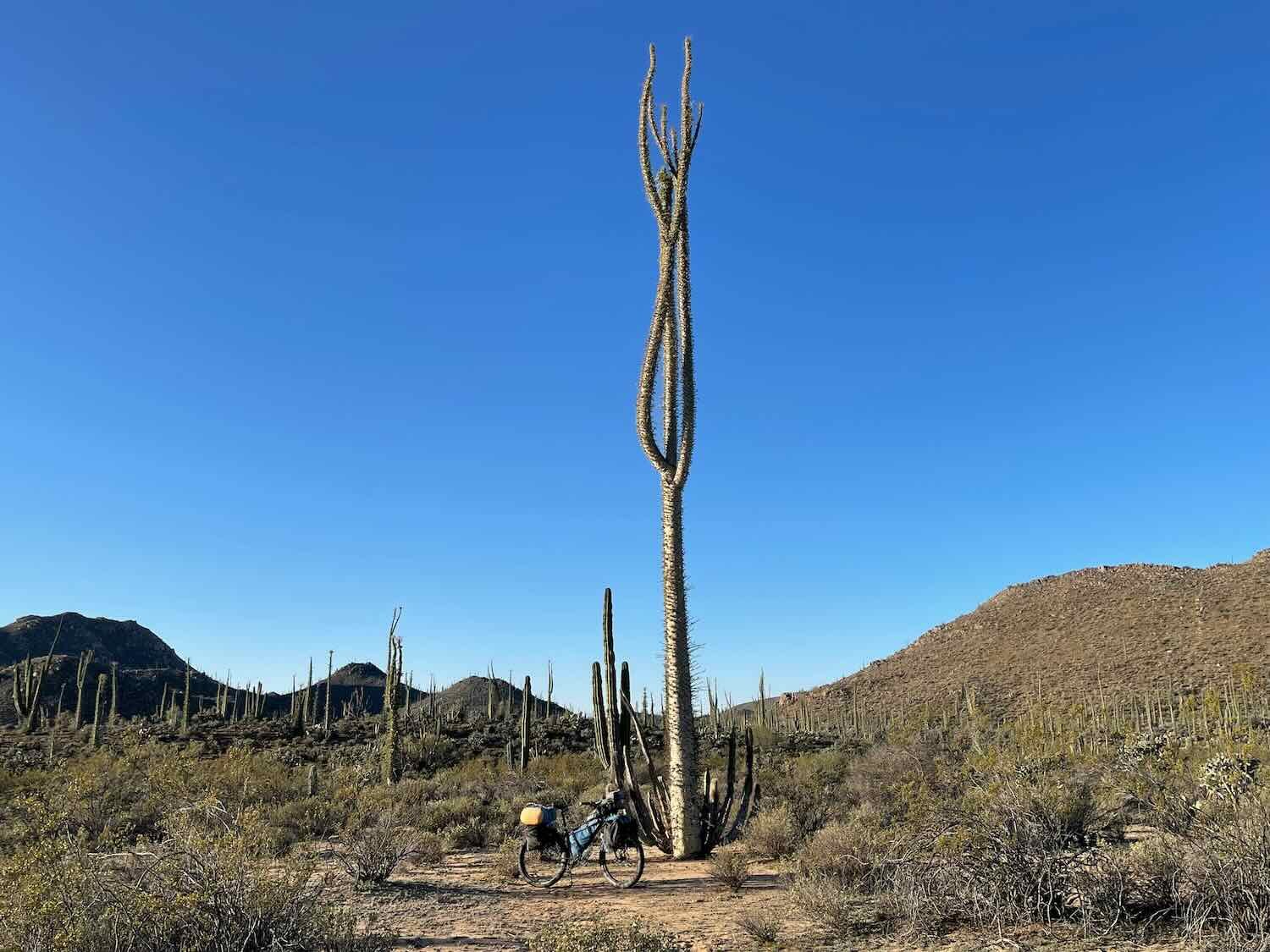
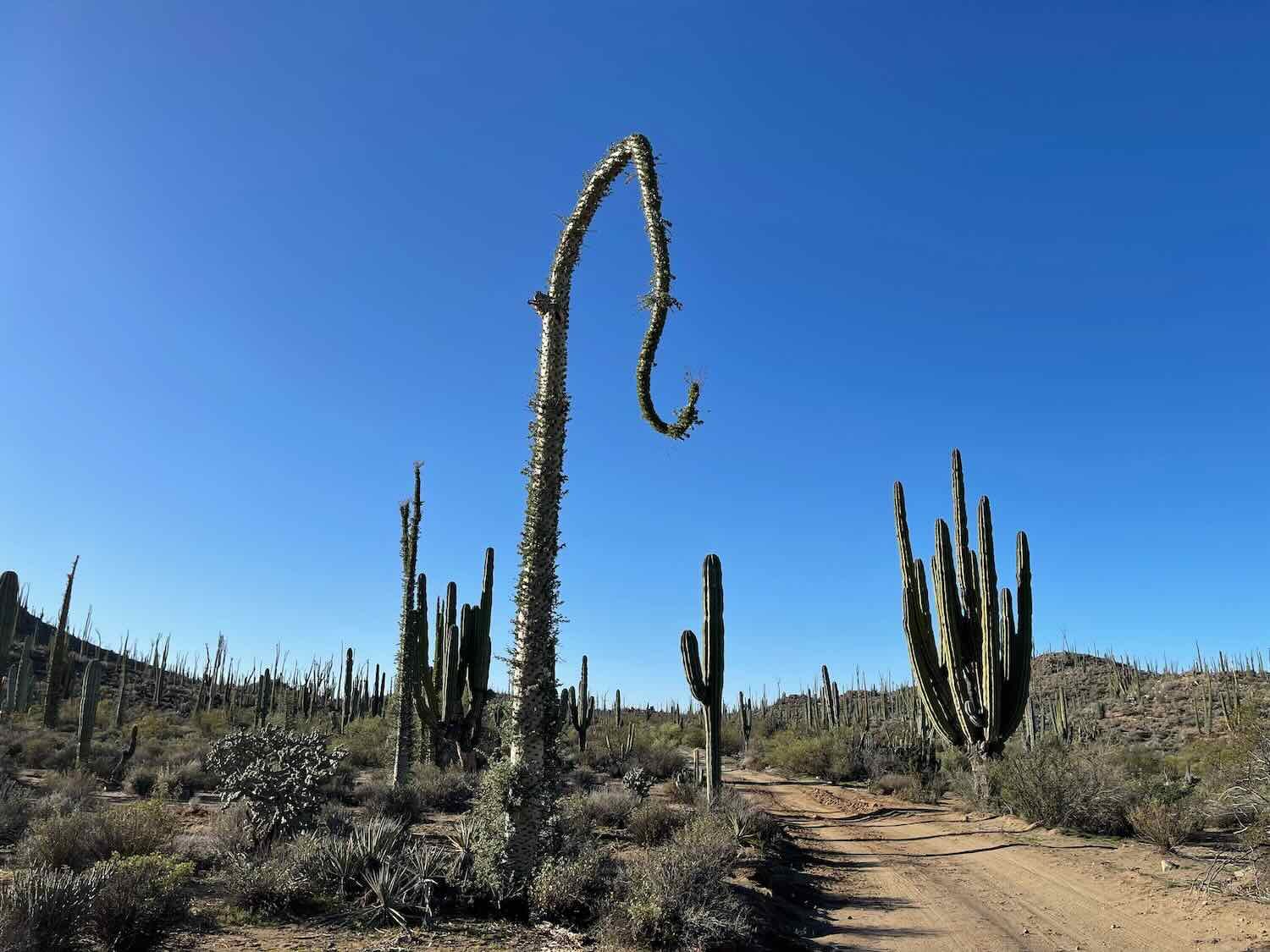
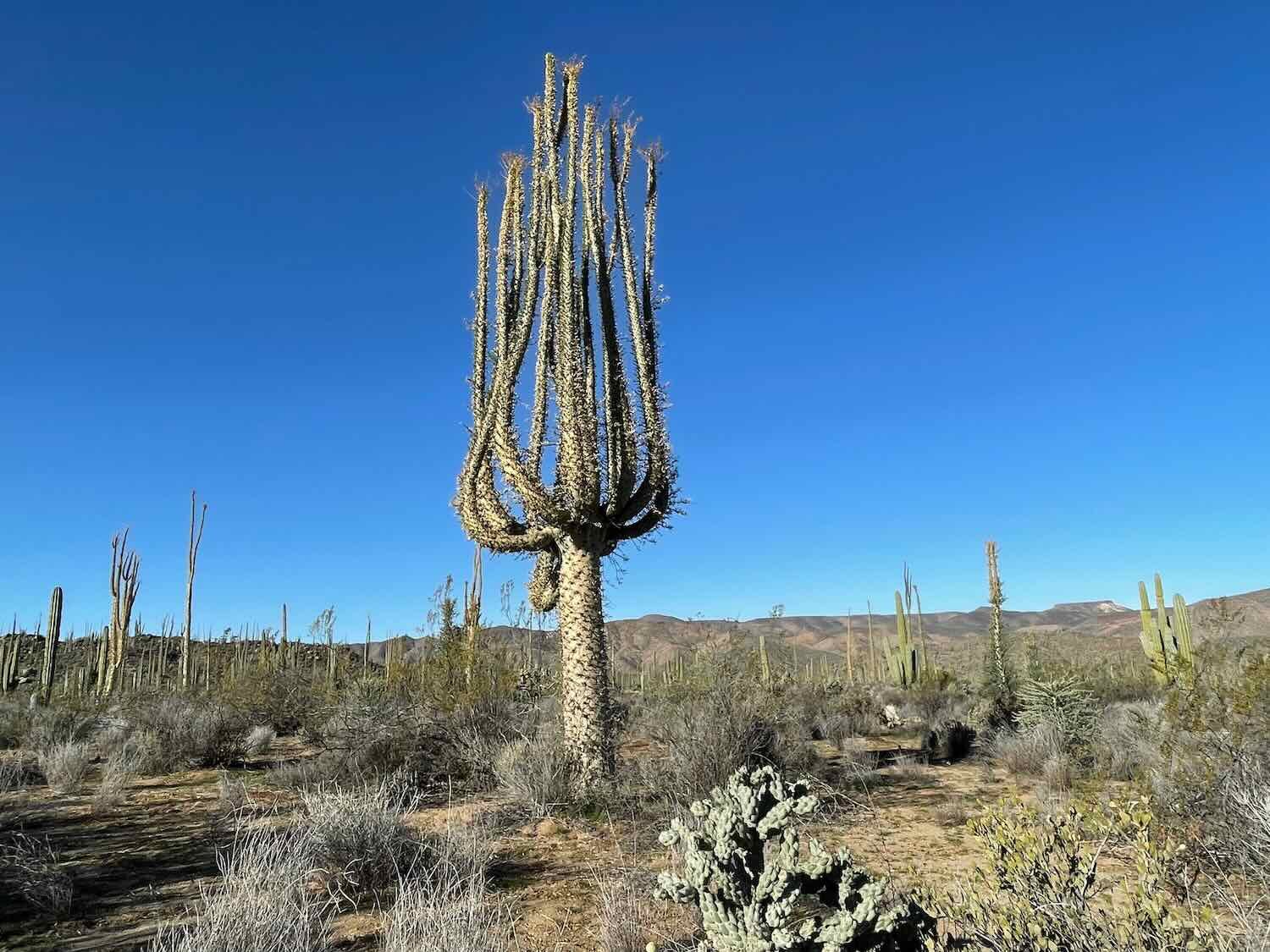
Western bluebird. Valle de los Cirios, Baja California, Mexico. Copyright © 2019-2023 Pedals and Puffins.
A little over two hours into the ride, we hit a snag. Our road disappeared into a fairly deep pool of algae-filled water. We could see the tracks of the other cyclists that had passed us a couple of days ago, so we followed them along the edge of the pond, hoping they would lead to a manageable crossing. Sure enough, there was a spot where the water looked pretty shallow. But the soil was a soupy muck that was impossible to ride through without bogging down. The day was very warm and sunny, so we both donned our sandals and waded across.
Wading across the big pool of water. Valle de los Cirios, Baja California, Mexico. Copyright © 2019-2023 Pedals and Puffins.
Further down the road we spotted our first Baja coyote. We had heard them calling many nights, but they had so far eluded us during the day. Valle de los Cirios, Baja California, Mexico. Copyright © 2019-2023 Pedals and Puffins.
A free-range horse and mule took refuge in the shade of a giant cardón cactus. Valle de los Cirios, Baja California, Mexico. Copyright © 2019-2023 Pedals and Puffins.
The road surface for the rest of the day was incredibly inconsistent, switching abruptly from easy riding to sand, to loose stones. As a result, our pace varied a lot. But we were able to ride our bikes, and move along at a good pace most of the time.
We spotted this western patch-nosed snake by the side of the road. They get their name from an enlarged scale on the snout, which they use to dig up buried lizard eggs - their favorite food. Cerro de San Miguel, Baja California, Mexico. Copyright © 2019-2023 Pedals and Puffins.
A Welcome, Hearty Meal
Even with all the stops, we covered the miles to the tiny restaurant at El Sacrificio, with a population of 4 people, by early afternoon. Juan, the proprietor, was very friendly and offered to make us anything we wanted, as long as it was eggs. There was no menu, only his repeated suggestion that we might like huevos rancheros. Unsurprisingly, we decided on huevos rancheros, which could have either been the house specialty or the only thing Juan knew how to make, we were not sure. It seemed best to just go along. Almost anything would have been fine by us, since we were very hungry. As he prepared our food, Juan chatted with us in Spanish. We learned that he had worked for several years near Portland, Oregon. He also told us that five cyclists had stopped at the restaurant the day before, which must have been the folks we met a couple days ago. They seemed to be pushing hard.
The small, modest restaurant at El Sacrificio. Baja California, Mexico. Copyright © 2019-2023 Pedals and Puffins.
Juan made everything from scratch, so it took him quite a while to prepare our lunch. The upside was that we had the chance to cool off and get very well hydrated. The refrigerator had a pretty limited selection of drinks, but oddly enough was well supplied with canned coconut juice, which we consumed in large quantities. Coconut juice has lots of electrolytes, kind of like natural Gatorade. When we left, about an hour later, we were well fed and no longer thirsty.
That was a good thing. Because when we arrived at the store in El Descanso, a couple of miles up the highway, where we had hoped to resupply, we discovered that they were no longer in business. Fortunately, the guy who runs the tire repair shop in the same area, had a big tank of purified water, and he was happy to let us fill up our bottles for the next backcountry leg of our trip. Eager not to run short on water again, we filled our bottles with 14 more liters.
Back Into the Desert
From there we zoomed up the paved highway, and quickly covered the 5-or-so miles to the next turnoff. But then things got messy. Right after turning onto a dirt road, we encountered a barbed wire fence - with no gate - that went directly across our line of travel. Some of the roads are so untravelled in Baja that it seems rather common for ranchers to put up fences that block the road without putting in a gate. For a minute or two we debated what to do. But with the evening approaching, we didn’t have time to seek out an alternative route. The gap under the bottom wire was pretty big, so we pushed our bikes under and kept going.
There was just enough room to squeeze our bikes under this barbed wire fence. El Descanso, Baja California, Mexico. Copyright © 2019-2023 Pedals and Puffins.
It wasn’t long before we came to another barbed wire fence. This one was not as easy to get through. We had to play around with the wire to inch it up high enough to get the bikes under. We managed. Unfortunately, we also lost a bunch of time negotiating last the couple of fence crossings. It is amazing how there is always something to slow you down in Baja. We have found that, on average, one mile of dirt road in Baja takes about as long as 2-4 miles on pavement, at least for us.
Not long after maneuvering under the second barbed wire fence, our road merged with a much bigger and better-maintained road. When the route on our phones appeared to go off to the left on a very rough track, involving yet another fence crossing, we opted to stay on the better road instead. We figured that they would reconnect somewhere up ahead. But they didn’t.
We ended up approaching a building guarded by two vigorously barking dogs. As we puzzled about what to do next, a guy came out and told us we needed to head to the left to reconnect with our route. He laughed and said that a number of other cyclists had already come that way over the past week. At least we weren’t the only ones who got off track.
He walked us across a gravel area to a break in his fence, and pointed out a way back to our road. But there wasn’t a path. We had to bushwhack through some brush, sidestepping the cacti, and maneuvering our bikes down a rough hill. It was not ideal. When we finally made it to our (much rougher) road, we checked our tires for cactus spines. That was a good idea, because we ended up removing a few.
By this time the sun was close to setting, so we didn’t go a whole lot further. We took the first camping spot we could find and pitched our tent adjacent to the road in the fading light. We were pretty sure there wouldn’t be any motorized vehicles on “our road” since there were at least three un-gated fence crossings to keep anything but the most persistent Baja Divide cyclist from passing. On the bright side, we didn’t need to make much food for dinner since we had eaten so much in El Sacrificio. We had a relaxing meal of tuna sandwiches by the light of a full moon on a cloudless night.
We did have some excitement, though. PedalingGuy was still wearing his sandals. And in the dark, he stepped on an old cactus bulb. The spines lodged themselves securely in both his sandal and his foot. We had to get out the Leatherman pliers to remove the spines. Fortunately, no serious damage was done. We had been duly warned by another cyclist that the one thing you want to be sure to take on a Baja bike trip is a pair of long nose pliers. Catcus spines seem to jump out of nowhere. So we were prepared.
A chunk of cholla cactus stuck in PedalingGuy’s foot. That’s one of the hazards of setting up camp in the dark. Valle de los Cirios, Baja California, Mexico. Copyright © 2019-2023 Pedals and Puffins.
By 7:30am the next morning it was already getting warm in the sun. We cycled out of the cool canyon where we had camped, and pretty soon we were peeling off layers of clothing. The route crossed a broad plain with relatively easy riding. So we were able to take the time to enjoy the scenery, and check out some of the flora and fauna along the way.
Morning light, cycling through the cactus forest. Valle de los Cirios, Baja California, Mexico. Copyright © 2019-2023 Pedals and Puffins.
After exiting the canyon where we had camped, we cycled across a large, open plain encircled by mountains. Valle de los Cirios, Baja California, Mexico. Copyright © 2019-2023 Pedals and Puffins.
We spotted a sage thrasher singing among the low-lying shrubs. Valle de los Cirios, Baja California, Mexico. Copyright © 2019-2023 Pedals and Puffins.
In the late morning we crossed a rocky ridge, and for the rest of the day we enjoyed a gentle downward trend. But just to keep things interesting, there was a constant roller-coaster of small, narrow arroyos. And most of them had very deep, powdery sand at the bottom. Those slowed us down as we tried not to topple over by hitting the sand traps too quickly.
There were tons of arroyos, often with steep, rocky descents and a deep sand pit at the bottom. Valle de los Cirios, Baja California, Mexico. Copyright © 2019-2023 Pedals and Puffins.
Slowing down to avoid tipping over in the powdery sand at the bottom of an arroyo. Valle de los Cirios, Baja California, Mexico. Copyright © 2019-2023 Pedals and Puffins.
At one point a small herd of horses approached us. They seemed to be expecting something from us, since they actually started running toward us when they spotted us from a long distance away. We suspected a local rancher had trained them to come running for a treat whenever he wanted to round them up.
By the time we stopped for the evening we were actually a bit ahead of schedule, with only four miles to go before reaching the next restaurant back out on the highway. It felt great to stop with plenty of daylight left, and not have any worries about our pace, and whether or not we would make it to the next resupply before running out of water. We found a nice, open and level camping spot among the desert brush, which helped to hide our location from the road. Although no one passed by, it still seemed wise to be discreet when camping so close to the highway.
Since we had extra time in the daylight, we decided to try using wood to cook our dinner. Our Trail Designs stove is supposed to work as both an alcohol stove and a wood-burning stove. But so far we had only used it with alcohol. This would be our first attempt using it with wood. We gathered up a bunch of dried branches from the surrounding bushes, and pretty soon we had a roaring fire going. But with the time spent gathering the wood, waiting for the fire to die down to a nice bed of coals, and bringing the water to a boil, the whole process definitely took a lot longer than just lighting up the alcohol stove. Even though we had gotten an early start, it was still well after dark by the time we were finished. Luckily, the full moon provided some extra light in the darkness.
Our wood-fired stove, cooking up dinner. Valle de los Cirios, Baja California, Mexico. Copyright © 2019-2023 Pedals and Puffins.
Another tricky part about using wood to cook was that it produced a lot of soot. When we were done, the stove was covered in slightly oily, black powder. We tried wiping some of it off with a napkin, but that got our hands all dirty. We’ll have to figure out how to be more clever about dealing with the soot in the future.
There must have been quite a bit of moisture in the air overnight, because our tent was crusted with ice in the morning, both inside and out. Fortunately, the first rays of sunlight shown onto the tent. This time we allowed ourselves the luxury of staying in our sleeping bags until the sun melted the ice. We watched lazily as the water droplets formed and rolled off the tent onto the ground. When we finally got going, the air was starting to warm up nicely.
However, our ride started off with some confusion. When we got to the place where our GPS showed the road, there was just a faint track that was overgrown with plants. It didn’t seem right. But faithfully, we tried to follow the GPS track. That led us to a large, sandy area with no apparent road at all.
It took us some time to sort things out. Eventually we bushwhacked our way over to what appeared to be a more heavily-used track. This one had evidence that other bikes had gone through recently, so that was a good sign. And pretty soon it turned into something resembling a real road. After that, we were able to make forward progress.
Bushwhacking through the vegetation, trying to find our road. Valle de los Cirios, Baja California, Mexico. Copyright © 2019-2023 Pedals and Puffins.
Back in Civilization
Before long, the cirios and cacti returned to the landscape. As we approached the highway, we saw a cluster of buildings. But they all looked abandoned, as if they were projects that had been started, and never completed. One looked like it was destined to be a hotel. Another looked like it could have been a gas station. But none of them appeared to have ever served their intended purpose. We started to wonder if we would find a restaurant here at all.
Then, off to the right, we saw a rundown building with a sign saying that it was a trailer park. There were no trailers. But the building did look occupied, so we figured we could go there and ask about a restaurant.
We cycled up and peered through the window on the door, and it indeed looked like a restaurant with a couple of tables inside. But the door was locked. We called out, “Hola, buenos días,” in hopes that someone would hear us and be able to direct us to food.
Pretty soon a woman came around the side of the building and opened the door. And, yes, to our utter delight, this was a restaurant and we could order breakfast. Things were definitely looking up. The proprietor was a wonderfully sweet lady and an excellent cook. We ended up having delicious, big omelettes with fries, beans and tortillas. There was plenty to eat and drink, and we were stuffed by the time we left. At the last minute, we also decided to buy an extra liter of water for the road. That turned out to have been a good decision. The next store down the road, where we had planned to buy a few things, appeared to not be in business anymore despite the big “abierto” (i.e., we’re open) sign out front.
The restaurant at San Augustín doesn’t look very promising from the outside. But it has a cozy restaurant inside. We were the only customers during the 90 minutes or so that we were there, and received the full attention of the owner. San Augustín, Baja California, Mexico. Copyright © 2019-2023 Pedals and Puffins.
By the time we left the restaurant, a very stiff crosswind had begun blowing (20 mph, with gusts to 30 mph). That slowed our progress. We labored into the wind for several miles before deciding it was time to remove our daBrims (the broad rims that attach to our helmets for sun protection). The daBrims are great, unless there’s a lot of wind. Then they become very unwieldy and a huge headache. They’re so good at catching the wind that they can make riding a straight line difficult. We pulled over to the side of the road and stowed the daBrims in our bags.
A few miles later we decided to stop again, to put some extra air in our tires. We had been riding them a bit soft on the dirt, but that slowed us down now that we were cycling on pavement. On the side of the highway, we inflated our tires close to the maximum. And while we were at it, we figured it couldn’t hurt to clean and lube our chains. After that, the riding was a quite a bit easier.
The scenery from San Augustín to Cataviña was quite majestic. Some people consider the area around Cataviña to be the most scenic section of Hwy 1. The massive granite boulders that had been present off-and-on since we left Tecate became the dominant landform. There were piles of them jumbled everywhere, surrounded by stunning, dense forests of cardón cacti. Along one section of the road there seemed to be a local custom of people spray painting the rocks with graffiti, which wasn’t very attractive. But a sign put up by a local community group described how they had a program to clean the graffiti off of the rocks, and asking people to refrain from adding more. Hopefully they’ll eventually get on top of the problem.
A cactus forest surrounds a mound of granite boulders. Valle de los Cirios, Baja California, Mexico. Copyright © 2019-2023 Pedals and Puffins.
The highway here was very narrow with no shoulder. But it wasn’t too much of a problem, because traffic was very light. Plus, the road was in excellent condition, so the cycling was easy. Arriving in Cataviña, we headed straight for the Hotel Misión de Cataviña (a sister hotel of the one where we stayed on the beach in Santa María).
The town feels a bit neglected, except for the hotel and a mini-mart across the road. That was a bit surprising, since Cataviña seemed to be an important stop-over point for off-road vehicle enthusiasts and for tour buses on the way to whale watching sites further south. Fortunately, we were able to get a nice, big room with working hot water, heat, and thick walls that kept the rooms nice and quiet. The only negative was that the wifi was awful - with barely a pulse. That was to be expected, given that it’s a satellite service.
This was the only gas station in town. Cataviña, Baja California, Mexico. Cataviña. Copyright © 2019-2023 Pedals and Puffins.
A herd of motorbikes parked outside the Misión Santa Cataviña Hotel. The town seemed to be a popular base camp for off-road enthusiasts. Cataviña, Baja California, Mexico. Copyright © 2019-2023 Pedals and Puffins.
Resting Up in Cataviña
We were ready for some time off the bikes. PedalingGuy had officially come down with a cold. He’d had a bit of a sore throat and cough out on the trail, but didn’t seem to feel sick. Now the symptoms had gotten worse, and he didn’t have a lot of energy. We ended up spending three days in Cataviña to give him time to recuperate, as well as getting our stuff ready for another big backcountry segment of the route.
On the evening of the first day we walked across the road to the mini mart, and ran into two cyclists who were there. One of them turned out to be Connor, who we had met with Carson and Adam out on the trail to El Sacrificio. He was in an upbeat mood, getting ready to head out into the night on his bike. It was nearly 6pm, and the sun had already set. But he was itching to get back out on the trail.
We learned that a couple of days ago he had left Cataviña with Carson and Adam. But about 19 miles (30 km) down the trail he suddenly couldn’t pedal. It turned out that the bolt in his crankset had been stripped. He said he had to “limp back” to Cataviña, and catch a bus back north to FASS Bikes (where every cyclist who’s in trouble on the Baja Divide goes), for repairs. He had just returned from that diversion, and wanted to put in some trail miles before bedtime.
The Baja Divide is really hard on bikes, and mechanical problems are very common. This can present some challenges, since bike shops are rare. And when you do go to one of the few bike stores in Baja, their selection of parts tends to be sparse. Having a good understanding of how to repair your own bike, and carrying a range of tools, can be invaluable. Unfortunately, as was the case for Connor, sometimes there is nothing you can do but stop riding until you find the essential part you need.
Before he left, Connor let us know that Carson and Adam were now cycling with George, our fellow Tumbleweed cyclist from Germany, and another cyclist who we hadn’t met. Apparently the new guy is riding a Tumbleweed bicycle as well. We also learned from Connor that Fred had managed to walk his bike back out to the highway after his tire disaster, gotten his tire replaced at FASS Bikes, and was now back on the route ahead of us all - having taken a bus down to Cataviña after his repair. We were glad to hear Fred had made it out okay.
The Baja Divide’s “Infamous” Section 8
On the third day, PedalingGuy was feeling better so we finalized our preparations for the next leg of route. Upon leaving Cataviña, we would head out on the infamous Section 8 of the Baja Divide. As noted at the top of this blog post, this is the longest section of the route without any access to reliable food or water supplies. Running for more than 125 miles (200 km), the route crosses the Baja desert before reaching a remote fishing village on the Pacific coastline (no services or potable water). Heading south along the coast, the route eventually rolls into the small fishing community of Santa Rosaliíta (population. 220). Fortunately, the terrain is a bit less formidable than some of the more mountainous sections. Many people complete the section in three days, but we decided to take our time and plan conservatively for four days of riding (with three nights of camping).
That was going to require a lot of food and water. We would start the trip with 13.5 L of water each. That meant we would each be carrying nearly 30 lbs of water in addition to our other gear. Plus, we had to figure out how to get all of that water onto our bikes. We both had to do some rearranging of our gear to get all of the extra containers on board. For food, we decided to stick with ramen and oatmeal for dinners to keep the weight as light as possible.
The first day out of Cataviña would be a long one. In terms of logistics, we needed to cycle as many miles on the first day as possible. That way, if disaster struck on any of the remaining days we would have a bit of a buffer, allowing us to take shorter days without getting in serious trouble. We decided that we would have to cover at least 35 miles on the first day, but that we would cycle as long and far as possible beyond that to create a cushion going forward. With that goal in mind, we were up and out the door right around sunrise.
On our way out of town we saw another cyclist with his bicycle and gear waiting at the side of the road. We stopped to make sure he was okay. He told us he was waiting for a bus to take him south. He had decided to skip Section 8. It was another indication of how bad the reputation of this section is among cyclists.
Just outside of Cataviña we passed an oasis along the side of the highway. The palm trees and water looked inviting in the morning light. Cataviña, Baja California, Mexico. Copyright © 2019-2023 Pedals and Puffins.
The first 45 minutes of cycling were uphill, on the paved highway out of town. But once we turned off the highway and onto the dirt, the overall trajectory was downhill as we headed for the coast. That made a big difference in how fast we could go. For the next nine miles, we cycled almost as fast as we had on the highway.
Pretty soon we encountered two more of Baja’s iconic, endemic plants. The first one was the Baja elephant tree (a.k.a., torote). Groves of these stout trees covered some of the hillsides, creating miniature forests. There are several different explanations for the name, but they all derive from the thick, gently curving trunk. Some people think it looks like the leg of an elephant. Others say that the tree looks like the trunk of an elephant reaching up out of the ground, holding a bouquet of leaves.
A Baja elephant tree. Valle de los Cirios, Baja California, Mexico. Copyright © 2019-2023 Pedals and Puffins.
Further toward the coast we began to see tall, skinny yuccas that looked a lot like the Joshua Trees that are found in the Mojave desert of California - but with a lot fewer branches. These turned out to be Baja yucca trees (a.k.a., datilillo). Looking a lot like a very tall bottle brush, these trees often dotted the landscape in areas that seemed to be too harsh for other cacti and trees.
Baja yucca trees often dotted the landscape in places where other trees were absent. Valle de los Cirios, Baja California, Mexico. Copyright © 2019-2023 Pedals and Puffins.
There continued to be plenty of cardón cacti and cirio trees as well.
Cycling through a forest of cardón cacti. Valle de los Cirios, Baja California, Mexico. Copyright © 2019-2023 Pedals and Puffins.
Although this region is extremely remote, sparsely populated, and considered to be part of the Valle de los Cirios Nature Preserve, it also encompasses some ejidos. Ejidos are indigenous lands owned communally by the residents. Often, only a small portion of the lands are occupied or used for agriculture. The rest are only lightly used, or left in a natural state. That’s especially true in the deserts. But once in a while we would come across a bit of ejido infrastructure. About four hours into our ride, we passed a picnic area with covered tables that was built by the ejido that claims these lands. After weeks of cycling in Mexico, these were the first picnic tables we had encountered. It was the perfect spot to take a break in the shade.
Stopping for a break at a remote picnic area. Valle de los Cirios, Baja California, Mexico. Copyright © 2019-2023 Pedals and Puffins.
By then we had gotten into more rugged country. Although the overall trajectory was still downhill, we cycled through a roller-coaster of hills crossing an endless series of arroyos. Some were quite steep, if not that long. But our bikes were so heavy with food and water for four days that it was very tiring.
Cycling through the hilly coastal range. Valle de los Cirios, Baja California, Mexico. Copyright © 2019-2023 Pedals and Puffins.
After seven hours of cycling, we came to another nice rest spot. The Ejido San José had built a community center out in the desert, with sturdy concrete-block picnic tables and a building that looked like it could be used for meetings. Unfortunately, the wooden parts of the building - including the doors and roof - were badly deteriorated. It looked like the place had not been used for quite a long time. Still, it was interesting to peek inside. There were faded educational posters on the walls describing some of the local plants and animals.
In the end we covered a respectable 45 miles (72 km) for the day - well past our minimum goal of 35 miles. In fact, this was the longest mileage day we had completed since leaving San Diego. It felt good to have made that much progress. We would still have to average around 27 miles/day for each of the remaining three days, but that seemed within reach.
The next morning we arose again at first light, hoping to put in another long day. As we departed camp, the surrounding desert was alive with birdsong. Cactus wrens, mockingbirds, and Scott’s orioles darted among the yuccas and shrubs, defending their territories from interlopers.
A male Scott’s oriole kept a close eye on his territory, chasing away any intruders. Coastal Range, near San José del Faro. Baja California, Mexico. Copyright © 2019-2023 Pedals and Puffins.
Cycling the 7.5 miles (12 km) to the small fishing village of San José del Faro seemed to take forever (it actually took 2.5 hrs). It was extremely slow-going. We scrambled over more than a dozen ridges between steep-sided arroyos. Each time we crested one of the high hills, we would get a glimpse of the Pacific Ocean, slowly drawing closer. That was a real motivator, and kept us pushing with the goal of finally reaching the coast.
An old fishing boat rests within sight of the Pacific Ocean. Known as “pangas,” these sturdy skiffs are popular for their ability to be driven by a relatively small outboard motor, and are commonly launched directly from the beach. This can be quite exciting to watch when the surf is up and the boats end up nearly vertical as they hit the crest of an incoming wave. San José del Faro, Baja California, Mexico. Copyright © 2019-2023 Pedals and Puffins.
When we finally pedaled through the tiny fishing village, it seemed almost deserted. There weren’t any people out and about. Apparently there are only three permanent inhabitants of San José del Faro. But seasonally there must be a lot more. There were 6-8 cabins clustered on a hillside overlooking a protected bay. Out on the sandy beach a handful of trucks were parked in a row, waiting for their owners to return by boat from the sea.
There wasn’t any reason to linger in town since there weren’t any stores or restaurants, so we just cycled through. Rumor has it that an occasional cyclist is able to buy a home cooked meal of lobster or fish caught offshore, but since we didn’t see anyone in the village we were out of luck. Our route led out onto the beach, then crossed a low levee between the sea and a shallow lagoon.
Water flowing out of the Arroyo San José doesn’t reach the ocean this time of year. It sinks into the sand in a shallow lagoon next to the road. San José del Faro, Baja California, Mexico. Copyright © 2019-2023 Pedals and Puffins.
On the far side of the bay the road climbed quickly up onto a rocky headland. Ready for a break, we stopped at an overlook for a lunch of saltines and cheese. The view was beautiful, as we watched the parade of waves lap up against the shore. Not far away, a bunch of sea lions were lounging on a rocky outcrop in the cove. We could hear them barking in the wind as we ate. Before long, a fishing boat came speeding back into the bay. With surprising efficiency, the captain steered the boat through the surf and hauled it out of the water with one of the pickup trucks that had been parked on the beach.
Our lunch spot overlooking the Bahía San José. San José del Faro, Baja California, Mexico. Copyright © 2019-2023 Pedals and Puffins.
A panga boat speeding through the surf towards the shore. San José del Faro, Baja California, Mexico. Copyright © 2019-2023 Pedals and Puffins.
After departing the bay, our route climbed back into the hills. Before long we were looking down on the village from the heights of another ridge. San José del Faro, Baja California, Mexico. Copyright © 2019-2023 Pedals and Puffins.
From there, the Baja Divide threw us another curve ball. It seemed as if the road surface on this section of the route had deteriorated a lot over the past couple of years. For the next five hours the cycling was very, very difficult as our route clambered over a series of steep, rocky ridges. Both the ascents and descents were littered with crevasses and loose rocks of all sizes. Our speed slowed to a crawl of just over 2.5 mph (4 kph). We were still carrying quite a bit of water, which made the hills even tougher. Some of them were so steep and slippery that PedalingGal couldn’t get enough traction to push her bike up, and needed an extra hand from PedalingGuy. For a while it seemed like we wouldn’t have a prayer of cycling the 25+ miles we had hoped to cover for the day.
The landscape along the coast was strikingly sparse, with very low plant diversity. There were no cirios or elephant trees, and the cacti were almost all gone.
Cycling through the steep and sparsely-vegetated hills. South of San José del Faro. Baja California, Mexico. Copyright © 2019-2023 Pedals and Puffins.
There was one section, about a mile long, where the route hugged the coastline and the road was relatively flat. But the cycling was still tricky because we found ourselves riding on loose stones. The ocean had built up a high berm of polished stones between us and the sea. And lots of the smooth, slippery stones had tumbled down into the road. It was like riding bikes on giant marbles, densely packed together. Before long, we were back in the hills.
A high berm of cobblestones separated our road from the beach. Lots of the cobbles littered the road surface, making for some squishy riding. South of San José del Faro, Baja California, Mexico. Copyright © 2019-2023 Pedals and Puffins.
Although vast expanses of the coastal hills had no vegetation taller than about a foot, we occasionally came upon small clusters of Baja yucca trees - especially at lower elevations. These “forests” of yucca, plus the gorgeous views of the ocean from the mountain heights, provided most of the visual interest for the rest of the day.
A “forest” of Baja yucca trees. South of San José del Faro. Baja California, Mexico. Copyright © 2019-2023 Pedals and Puffins.
Cycling through the bleak landscape. South of San José del Faro. Baja California, Mexico. Copyright © 2019-2023 Pedals and Puffins.
Pushing up another hill, with the beautiful Pacific Ocean in the background. South of San José del Faro. Baja California, Mexico. Copyright © 2019-2023 Pedals and Puffins.
We had seen hardly any vehicles since leaving Cataviña, with the exception of the trucks parked on the beach in San José del Faro. Part of the reason was certainly that the road was in such bad shape that it must have been impassable by most vehicles. But at some point during the afternoon, two guys on motorbikes approached us from the other direction. That was a good sign. At least the track ahead was passable by motorcycle.
They stopped to ask PedalingGuy for directions on how to find the road to Cataviña. It was pretty surprising that they would be traveling out in the Baja backcountry without a reliable GPS track. We gave them directions as best we could, but it was clear they would have some challenges since there were often multiple dirt tracks to choose from. We wished them good luck before they sped away.
Then, around 8.5 hours into our ride, our luck finally changed. We plunged down off of one last ridge and landed on a flat stretch of road with an improved gravel surface. It was glorious. We flew along as fast as we could on the easy road, trying to cover as many miles as possible before dark. It had taken us all day, but we cycled 26 miles (41.8 km) - good enough to keep us from having to worry about our water supply. Once again, we were happy campers. We even allowed ourselves to hope that the new, improved dirt road might last long enough for us to make even better time over the next couple of days.
We were still on the flats, so it was pretty easy to find a level campsite. But the absence of vegetation meant that our tent would be visible from the road, even from a distance. In the fading light, we wandered about a quarter mile off of the road, out into the desert, in an effort to be discreet. We also had to contend with the wind, which was blowing pretty hard. Without any vegetation to provide a windbreak, we tied the tent down with some extra guy lines just to be safe.
It Keeps Getting Better
The next day’s ride was infinitely easier than the previous day. Even on the biggest hills, the steep or rocky parts were short. Throughout the day we alternated between cycling by the sea and crossing over approximately ten major ridges that ran perpendicular to the ocean. The amount of salt in the soil was particularly noticeable. In the lowlands, the ground was often crusted with white salt crystals.
The white crystals in this photo aren’t frost. That’s salt forming a crust over the soil near the Baja coast. Punta Blanco, Baja California, Mexico. Copyright © 2019-2023 Pedals and Puffins.
In the first half hour after leaving camp, we even cycled past some large salt flats that had no vegetation at all. The soil out on the flats was mushy because of the recent rains. But there was a crust of salt on top. Tire tracks in the mud indicated that at least a few off-road vehicles had found their way out here to drive around on the flats.
Cycling across a salt flat near Punta Blanco. South of San José del Faro. Baja California, Mexico. Copyright © 2019-2023 Pedals and Puffins.
Cycling across the lowlands proved to be pretty easy, with lots of hard-packed gravel and clay. We occasionally ran into some sand, but as a general rule it wasn’t too deep. However, there was one section that gave us some trouble. One hour into our ride we crested a big ridge, only to see our road ahead disappear into a large, shallow lagoon at the bottom of the hill.
From the heights of this ridge, we could see a road disappear into the large lagoon below. We hoped that wasn’t our road. But, unfortunately, it was. Baja California, Mexico. Copyright © 2019-2023 Pedals and Puffins.
We eased our way down the rocky descent and came to a stop at the bottom. By this time it was clear that our road did, in fact, head straight into the water. We would have no choice but to bushwhack a few miles around the lagoon. We could go though some knee high bushes growing in muck, go out onto the beach which required going over some dunes and contending with soft unrideable sand, or take a very long detour up and over the mountains on the inland side of the lagoon. Well, the mountains were a no go, we had had more than enough of rough mountains lately. After trying to make our way through the shrubs and muck we decided to head for the dunes.
Our road disappearing into the waters the lagoon. Bahía Blanco, Baja California, Mexico. Copyright © 2019-2023 Pedals and Puffins.
This forlorn panga was marooned on the sand near the lagoon. Bahía Blanco, Baja California, Mexico. Copyright © 2019-2023 Pedals and Puffins.
Trudging over sand dunes, trying to find a path around the lagoon. Bahía Blanco, Baja California, Mexico. Copyright © 2019-2023 Pedals and Puffins.
Our trek over the dunes did have some benefits. We spotted quite a few interesting things that we might not otherwise have seen. In several low-lying swales, the ground was covered with highly polished, large and pearly seashells. We also startled a side-blotched lizard trying to hide in the sand.
But the going was just too rough, and our progress was really slow. After some deliberation, we decided to push our bikes out to the beach. That way we might be able to cycle on the hard-packed sand at the edge of the waterline, hopefully get past the lagoon, and pick up our road on the other side.
Cycling along the sand on the beach. This was a whole lot easier than pushing our bikes through soft sand dunes. Bahía Blanco, Baja California, Mexico. Copyright © 2019-2023 Pedals and Puffins.
Our problem now was that the tide was rising fast and the beach was getting smaller as we cycled south. We were getting pinned between the ocean and a large cobblestone dune on the other side of us. We hustled as fast as we could. But before long, the waves were lapping at our tires. To protect our bikes from the corrosive saltwater, we ended up cycling on the cobblestones near the foot of the dune. That didn’t work so well. As the stones got deeper, it became impossible to ride. Once again, we headed back inland.
We scrambled with our bikes to the top of the cobblestone ridge, and discovered that luck was finally on our side. We had made it past the lagoon. Even better, we crossed the berm right onto a 2-track path that led directly to our road on the other side of the lagoon. We were back in business.
Later that day we were struck by the sight of a large field of magenta-colored grass stretching as far as we could see. It turned out to be dwarf glasswort, a plant that grows well in very salty soils. Bahía Blanco, Baja California, Mexico. Copyright © 2019-2023 Pedals and Puffins.
By this time we were within about 50 miles (80 km) of the towns to our south, and had entered a region that is popular among surfers and overlanders. So although we had seen almost no one for the past couple of days, that was about to change. During the second half of the day, we started to notice more human activity.
The first folks we encountered were traveling in a group of seven side-by-sides. They came up behind us, and stopped to ask if we needed water. Sure! Although we were doing okay with our water usage, we’d already used up two days worth. So taking on a little extra would be great insurance. Plus, although we had an adequate amount of water, it wasn’t what you might call a satisfying amount of water. Having a bit more would be awesome.
Dean and Trish were incredibly generous. They gave us 3.5 liters of water, plus a couple of candies. Another woman, Karen, got out of one of the other vehicles and came over to talk with us, too. Dean had radioed the others and told them that we had cycled down from Alaska, and she wanted to meet us. We learned that they were on a group trip from Phoenix, Arizona. Everyone was wonderful and so kind to us. It made our day.
Trail angels Dean and Trish stopped to make sure we were okay, and gave us 3.5 liters of water. Bahía Blanco, Baja California, Mexico. Copyright © 2019-2023 Pedals and Puffins.
As soon as they left, we just sat down on some rocks by the side of the road and drank about a liter of water each. It was fantastic to have no worries about water, and to get fully hydrated. Of course, we ate the candies right away, as well.
After that we both felt a rush of new energy which lasted the rest of the day. Some clouds rolled in during the afternoon, keeping the temperature moderate. All of this helped us maintain a nice, brisk pace.
Afternoon clouds helped keep the temperature comfortable as we traversed the sparsely-vegetated plains. Bahía Blanco, Baja California, Mexico. Copyright © 2019-2023 Pedals and Puffins.
Later in the day we were passed by another caravan of six SUVs and jeeps. But it was after we started looking for a campsite that we realized just how many people were out on this stretch of the coast. This was the Baja of surfers’ dreams.
As we got close to the well-known, but now abandoned homestead called El Cardón, we began checking out some camping areas that were marked on our map. But the first two that we passed already had multiple campers and vans occupying the best sites. We noticed a few surfers out catching one beautiful wave after another in a protected bay. Once we passed the area with the bay, the landscape became very unsuitable for camping. It was really hilly, with virtually no level ground. Plus, the surface was either covered with sharp, golf-ball sized stones, or muddy clay. Things weren’t looking very promising.
We cycled past the El Cardón homestead, and reached a side road about a half hour later. We turned down the road toward the ocean, hoping to find an out of the way camping spot. And we were in luck. The road ended in a lovely cove near Punta Lobos that had quite a few level spots that had been cleared by previous campers. Near the water, the road split, with one branch going to the left, and the other to the right. There were 2-3 other vehicles already there, but they were all camping together down the right hand fork in the road. So we headed down to the left. We found a beautiful spot near the end of the road, pretty far away from the others. It was close enough to the top of the cobblestone berm to have a magnificent ocean view.
Our campsite near a secluded beach. Punta Lobos, Baja California, Mexico. Copyright © 2019-2023 Pedals and Puffins.
While we were pitching our tent, a nice guy came over from one of the other campsites to say “hi.” Apparently they were traveling in one of the vehicles that had passed us on the road. He said that cycling looked like thirsty work, and offered us a couple of beers. Such a great way to end the day. We chatted for a bit, and learned that he had driven down from Vancouver, Canada with friends. They had fallen in love with this cove, and had already been camping there for three days. Then he wished us well, and headed back to his campsite. For the rest of our stay, we had an entire section of the beach all to ourselves.
A Day at the Beach
Some time before midnight it started raining. Then, throughout the night, the wind would periodically whip up and it would rain again - usually hard at first, then tapering off into an extended, light rain. We were happy that we had pitched the tent low to keep out the wind. That kept us from getting water blown into the tent. Plus, the sandy soil didn’t accumulate puddles that could splash water on us. We stayed comfortable and dry.
Around 7am there was a break in the rain. We were able to pack up our things and enjoy a leisurely breakfast while sitting in our camp chairs, looking out over the ocean. We were both still tired - the rain and wind during the night kept us both awake. As we were getting ready to go, PedalingGuy joked that we should take a rest day here and just enjoy the beach. We had plenty of water and food, so it was definitely an option.
But when PedalingGal called his bluff and said okay, PedalingGuy waffled. We had been so focused on getting through the infamous Section 8 that it just didn’t seem wise to hang out at the beach for a day. We gathered up our things. But we hadn’t taken the tent down yet because we wanted to give it a chance to dry. At the last minute, we changed our minds, again. We would stay. It really was a great idea. The first thing we both wanted to do was to go back to bed!
We unpacked our things, crawled back into the tent, and wrapped ourselves in our sleeping bags. As we were falling asleep, it started to rain again. Suddenly we felt very smart. It made perfect sense to avoid cycling on the dirt roads in the rain. Of course, we should take the day off. Feeling particularly clever, we drifted off to sleep.
Shortly after noon, the sun finally seemed to be poking through the clouds. We decided to get up and go for a walk.
Just south of our campsite, the shore was all cobble stones and rocky outcrops. We explored along the edge of a cliff, and hunted for creatures in the tide pools. Tiny fish darted away. In the deeper pools, cream-colored and green sea anemones waved their fronds in search of food. Many of the pools had colonies of snails, leaving slender tracks in the algae that coated the rocks. It was really fun to explore.
Cobblestones washed up to fill the floor of a cove carved into the cliff. Punta Lobos, Baja California, Mexico. Copyright © 2019-2023 Pedals and Puffins.
Walking among the tide pools on the rocky shoreline. Punta Lobos, Baja California, Mexico. Copyright © 2019-2023 Pedals and Puffins.
It drizzled off-and-on as we walked. For a short time we took shelter from the rain in a small sea cave. We also had to keep an eye on the tide, which was coming in. A couple of times big waves came up onto the rocks, causing us to retreat further up against the cliffs. When the waves started getting closer, we headed back to camp. Then we just sat in our chairs watching the ocean. We were entertained by a few brown pelicans diving in the surf, and an eared grebe swimming near the shore. It was totally relaxing, and very Baja.
The sun never really came out that day, and by 3:30pm it was getting chilly. We decided to try to cook our dinner over an open campfire to generate some heat and save on our limited supply of alcohol for our stove. We spent the next hour scouring the neighborhood for fire wood. Judging by the existing fire rings and lack of firewood, others had enjoyed numerous campfires in the area. Our biggest problem was that the wood that we could find wasn’t fully dry because of the rain, and dead cactus isn’t at the top of the high quality firewood list. So starting the fire was really tough. We ended up having to use one of our fire-starters to finally get it going. Eventually the wood caught fire, and we were able to create a nice bed of coals. It was enough to throw off a bit of heat, and to boil a pot of water for our dinner.
Cooking dinner over the open fire. Punta Lobos, Baja California, Mexico. Copyright © 2019-2023 Pedals and Puffins.
The Road to Santa Rosaliíta
The next morning, with our abundance of water, we treated ourselves to a breakfast of Kachava - a plant-based, very nutritious, powdered drink that we had brought with us from the United States. We sipped our delicious, chocolate beverages while watching the waves come ashore. It was a particularly enjoyable way to start the day.
As we departed one of the most ideal campsites we have ever had, our route immediately climbed up a couple of hundred feet onto the top of a ridge. In the misty light, we could see our road striking off across a low valley and heading towards the gray, ominous, shadowy hills in the distance.
Our route heads across a lowland, toward the gray shadows of hills ahead. Punta Lobos, Baja California, Mexico. Copyright © 2019-2023 Pedals and Puffins.
Down in the valley we had our first encounter with “goatheads” - the giant sandburs infamous for draining air and sealant from bike tires. Fortunately, we did not fall victim to their spines today. North of Santa Rosaliíta, Baja California, Mexico. Copyright © 2019-2023 Pedals and Puffins.
Some of the bays we passed were ringed with sand dunes. North of Santa Rosaliíta, Baja California, Mexico. Copyright © 2019-2023 Pedals and Puffins.
The day stayed cloudy and cool, with rain threatening throughout most of our ride. Fortunately, although we cycled through a few sprinkles, the heavier rain never came. But because of the threat, we pushed the pace hard at times. We didn’t want to get bogged down in Baja’s sticky mud.
The road into Santa Rosaliíta is feared by cyclists because the heavier vehicle traffic has turned the road surface into a mess of deep washboards that extended for many miles. Some people actually avoid the Baja Divide’s Section 8 not because of the lack of services, but because they hate cycling on washboards. We encountered some tooth-rattling sections of road, especially in the first half of the day. But in truth, they weren’t any worse than the rocky roads we had already endured. And without the steep hills, they offered pretty easy cycling. Plus, there were many places where motorists had created parallel, secondary roads which had much smoother surfaces. We rode on those whenever we could. In the end, we didn’t find the washboards to be a problem at all.
Furthermore, the road did a pretty good job of staying on moderate slopes, even though a lot of the route passed through very hilly country. But wherever the hills got a bit steeper, we encountered some really massive gullies.
Rain had carved big ruts in some of the hillier sections of the road. North of Santa Rosaliíta, Baja California, Mexico. Copyright © 2019-2023 Pedals and Puffins.
As we got close to town, we spotted this modest sign for El Cactus restaurant - famous among Baja Divide cyclists for its fish tacos. The sign says it all. Santa Rosaliíta, Baja California, Mexico. Copyright © 2019-2023 Pedals and Puffins.
We rolled into the fishing village of Santa Rosaliíta (pop. 220) pretty early in the afternoon. It’s a quirky place. A smooth, paved road leads to a non-functioning port nearby, but all the roads in the village itself are rough dirt. We careened down a steep hill to find the village hugging the shoreline at the bottom of a cliff. After passing a few brightly colored homes and a charming church decorated with a seashell motif, we found the Hotelito Pacifico. It has only six, very small, basic rooms, and is operated out of the convenience store next door. Even with only six rooms, it is not clear that they are all in service. The rooms were so tiny that we had to rent two of them in order to fit both us, our bikes and gear inside all at the same time.
The local church. Santa Rosaliíta, Baja California, Mexico. Copyright © 2019-2023 Pedals and Puffins.
Our bikes parked outside the Hotelito Pacifico. The rooms were so small we had to rent two to fit all our gear, our bikes, and ourselves inside. Santa Rosaliíta, Baja California, Mexico. Copyright © 2019-2023 Pedals and Puffins.
After checking in we strolled over to El Cactus, the famous fish taquería in town. In pretty short order we devoured 12 tacos between us - six fish tacos and six shrimp tacos. They were delicious, as predicted. Antonio and Nidia, the owners, invited us to sign their fancy, new guest book. We were the fourth people to sign it, and we knew all three of the previous contributors: Fred (of the flat tire), Adam and Carson. We were happy to help Antonio and Nidia start their new tradition of welcoming Baja Divide cyclists with the book.
In another small world moment, the guy who had given us the beers at our last campsite was just outside the restaurant, using its wifi to make a call on his mobile phone. So we got a chance to say, “hi,” and to thank him one last time. He told us he wouldn’t be staying in town, but was heading out that afternoon to another campsite.
Enjoying an early dinner at El Cactus Restaurant. Santa Rosaliíta, Baja California, Mexico. Copyright © 2019-2023 Pedals and Puffins.
Having stuffed ourselves well with tacos, we went back to the hotel. After a much needed shower, we had time to take a walk around the village. The small marina along the waterfront was bustling with activity, as guys in pickup trucks came and went. There was a pretty big fish and shrimp processing building, but it was quiet when we walked by. At the far end of town was a large, unfinished building. We later learned that this had been part of a grand scheme to create a major harbor at Santa Rosaliíta where small boats from California could sail down, get loaded onto a truck, and be hauled across the Baja Peninsula to Bahía de los Ángeles on the Sea of Cortez. Dubbed the Escalera Náutica, this over-the-top tourist attraction never got off the ground. Instead, the hull of the administration building is slowly crumbling away.
A panga boat and lobster traps along the waterfront, in the evening light. Santa Rosaliíta, Baja California, Mexico. Copyright © 2019-2023 Pedals and Puffins.
After we returned to the hotel another blustery storm rolled in. For the rest of the night, strong winds and rain pummeled the village. We were glad to be inside, and out of the weather.
A Quick Run to Nuevo Rosarito
There had been quite a bit of rain over the past couple of days, leaving big, coffee-colored puddles in the dirt roads. We had also heard from other cyclists that the segment of the Baja Divide from Santa Rosaliíta to Nuevo Rosarito was infested with goatheads (the giant sandburs) that are tough on tires. On top of that, PedalingGal had a rough night. She had come down with the cold that PedalingGuy had in Cataviña, and didn’t sleep very well. And, finally, we were in the mood for some less bumpy terrain. So the next morning, with all our excuses lined up, we decided to cycle on the paved road to Nuevo Rosarito.
We found it amazing how the miles passed so swiftly on the asphalt, after having spent so much of the last few weeks on the rough dirt roads of Baja. There wasn’t much traffic between Santa Rosaliíta and the highway, giving us the chance to look around at the scenery while riding - rather than having to focus all our attention on how to navigate the road ahead. As we progressed, the sparsely-vegetated coast slowly gave way to the more diverse, inland desert with its cacti, cirios, and elephant trees.
A rose-colored butte rises over the surrounding desert, with cirios and elephant trees in the foreground. Between Santa Rosaliíta and Ejido Nuevo Rosarito, Baja California, Mexico. Copyright © 2019-2023 Pedals and Puffins.
Unfortunately, PedalingGal won the prize for getting the first flat tire between the two of us on the Baja Divide. It’s ironic that she got it on the pavement, instead of on the sharp, off-road rocks. But cruising down the highway, she suddenly heard the unmistakable, intermittent hiss of sealant escaping from her back tire. The hole was big enough that we had to plug it. But after that, the tire seemed to be as good as new.
After just two hours we arrived in Nuevo Rosarito. We went straight to Hotel El Cactus, the only hotel in town. But when we tried to check in, there was some confusion over the price. We’ve gotten pretty proficient in speaking the Spanish required to secure a hotel room, but for some reason PedalingGal got her numbers confused and thought that the asking price was much higher than it really was. We gave serious consideration to going down the road to another, even more basic hotel well outside of town, but changed our minds. For the convenience of being near the two tiny stores and the only restaurant in town, we were prepared to pay a bit more.
During the check-in, it became apparent that there had been a misunderstanding about the price. When we handed over 1500 pesos, we were given 1000 back. The room was actually pretty inexpensive. In the end everyone was happy, and we stayed.
An Unexpected Delay
We expected to stay only one night in Nuevo Rosarito. So after a quick lunch at the town’s only restaurant, we hit both of the town’s small abarrotes stores to buy the food we would need for the next leg of the trip. We hoped to head out in the morning over Baja’s central mountain range, and finally reach the coast of the Gulf of California in a couple of days.
Mauricio’s is the only restaurant in Nuevo Rosarito. Fortunately, the food was very good and a great value as well. Ejido Nuevo Rosarito, Baja California, Mexico. Copyright © 2019-2023 Pedals and Puffins.
Our hotel room was always chilly, but overnight it got really cold. The temperature dropped into the 30sF (3.5 C), and the wind was howling. When we awoke the next morning, the wind was blowing at a sustained 25 mph (40 kph), with gusts over 40 mph (65 kph). Plus, PedalingGal was still feeling under the weather from her cold. With those two factors working against us, we decided to spend another day in Nuevo Rosarito.
This was not as easy a decision as it sounds. The hotel room left a lot to be desired in terms of comfort. The room was very cold most of the time. There was no heat, and there were big gaps around the door, letting in a steady draft of “fresh” air. In the bathroom, there was no shower head (just a pipe coming out of the wall), and the hot water would run out quickly. Finally, there was quite a bit of noise from all of the activity in the immediate vicinity of the hotel, including a truck washing service, a rest area with loud music playing for most of the day, and various farm animals housed next to the hotel including chickens that liked to make loud chicken noises at dawn, and a very vocal donkey. On the bright side, it was a very short walk to the restaurant and grocery store. So we figured it would be okay for another day.
Trying to stay warm in our hotel room. There was no heater, and big gaps around the door let in cold air. Ejido Nuevo Rosarito, Baja California, Mexico. Copyright © 2019-2023 Pedals and Puffins.
The hotel room was designed for smaller people. PedalingGuy barely fit through the door of the bathroom. Ejido Nuevo Rosarito, Baja California, Mexico. Copyright © 2019-2023 Pedals and Puffins.
One of our more vocal neighbors. This friendly donkey lived in a pen just behind the hotel. Ejido Nuevo Rosarito, Baja California, Mexico. Copyright © 2019-2023 Pedals and Puffins.
That evening, we hit another snag. Over dinner, PedalingGuy let PedalingGal know that he had another toothache, and it had been getting worse for a couple of days. We both agreed that addressing the toothache took priority, and we’d have to make a change of plans. So we turned our attention to finding a dentist that could potentially perform a root canal operation.
It soon became apparent that all of the endodontist specialists in Baja are either in the far north (Enseñada and Tijuana) or south (La Paz). And, of course, we were now smack in the middle of the peninsula - hundreds of miles from either one. We spent the next day trying to figure out what to do. It didn’t help that the wifi at the hotel had almost no pulse at all, so it was very difficult to load web pages. We decided to try and catch a bus to Enseñada. But getting a handle on how to catch a bus in Nuevo Rosarito was somewhat mysterious at first, since there’s no bus station or even a formal bus stop. But eventually we scraped together some online information, and got confirmation of the bus’s timing from our hotel host and the ladies at Mauricio’s Restaurant.
Basically, we needed to wait out by the side of the road in front of the restaurant between 9-10pm at night, and flag down a passing bus. We also had to be ready to pay an as-yet-unknown amount of cash to the bus driver for our tickets (there were various estimates of how much it might cost). And we had to be ready to remove the front wheel and some of the bikes’ accessories for storage in the bus’s luggage compartment.
Our bikes take up a lot of room, so there would need to be a significant amount of storage space available. The bus company’s official policy is that bikes are not allowed on the buses, but other cyclists had used the buses so we were optimistic it might work. Nonetheless, it was certainly at the discretion of the bus driver, who hopefully was going to be in a good mood, not have a full bus, and be willing to pick up a couple ragged cyclists with bikes, late at night, at an unofficial bus stop. What could go wrong? It all felt a bit loosey-goosey. By the time we got all this figured out, we didn’t feel like we had enough time to get ready to leave that night, so we paid for one more night in the hotel. We would get everything in order and attempt to catch the bus the next night.
Detour to Enseñada, Mexico
The next day felt like a waiting game. We re-packed our panniers and loaded a bunch of stuff into our backpacks, to take with us on the bus. We also removed a lot of the more delicate items from our bikes (e.g., odometer, rear-view mirror, water bottles, etc.). Finally, we lowered the seat posts to ensure that the bikes wouldn’t be too tall to fit upright inside the luggage compartments. But the repacking didn’t take all day. With the hotel’s internet basically unusable, we wiled away the hours by taking a walk toward the residential part of town and hanging out in the restaurant (where the wifi was a little bit better).
Just after 9pm we went outside to wait for the bus. As an insurance policy, we left the hotel key in the room with the door unlocked. We had already paid for the night, so if we ended up missing the bus, at least we’d be able to go back inside to rest and regroup
It felt pretty sketchy waiting out by the side of the road at night. Both of the closest street lights on our side of the road were out, leaving us in a dark spot. The only light came from some outdoor lights on Mauricio’s restaurant, 40-50 yds away. Nuevo Rosarito is a popular stop with truckers, and while we were waiting several big semi-trucks exited the parking area, causing us to have to move out of the way. We had to constantly be on alert for vehicles that might have trouble seeing us in the dark.
But at 9:45, a big bus came towards us down the road. We turned on our headlamps to help attract attention, and PedalingGuy stepped forward to flag the bus down.
At first we thought the bus was going to keep going. It went right past us, and headed further up the road. But it seemed to be slowing, so we grabbed our bikes and started running after it. Sure enough, the bus eventually pulled over on the side of the road, about 60-70 yds from where we had been standing. It was a scramble to get the bikes onboard. First, we had to remove the front wheels. Then PedalingGuy worked with the driver to load the bikes onto the bus. Miraculously, they were able to create enough space for both bikes in the crowed baggage compartment.
We paid the driver in cash and boarded the bus. Unfortunately, it was pretty full. So our seats were at the far back, right near the bathroom. That meant we swayed and bounced all night as the bus sped along the winding mountain road. It was unpleasant for both of us. But PedalingGuy, who is prone to motion sickness, just tried to survive.
The ride took about 8 hours. We arrived at the bus station in Enseñada around 5:45am, just as dawn was breaking. We were delighted to have made it, and very relieved that our bikes came through unscathed. By 8am we had found a decent hotel with good wifi. We still had to wait until noon to check in, but things were definitely looking up. We wiled away the remaining hours at a fast food restaurant out on Enseñada’s main commercial strip. Then headed back to the hotel, ready to locate a dentist.

